Sustainable Housing in Australia PDF
VerifiedAdded on 2021/06/14
|24
|5706
|48
AI Summary
Contribute Materials
Your contribution can guide someone’s learning journey. Share your
documents today.
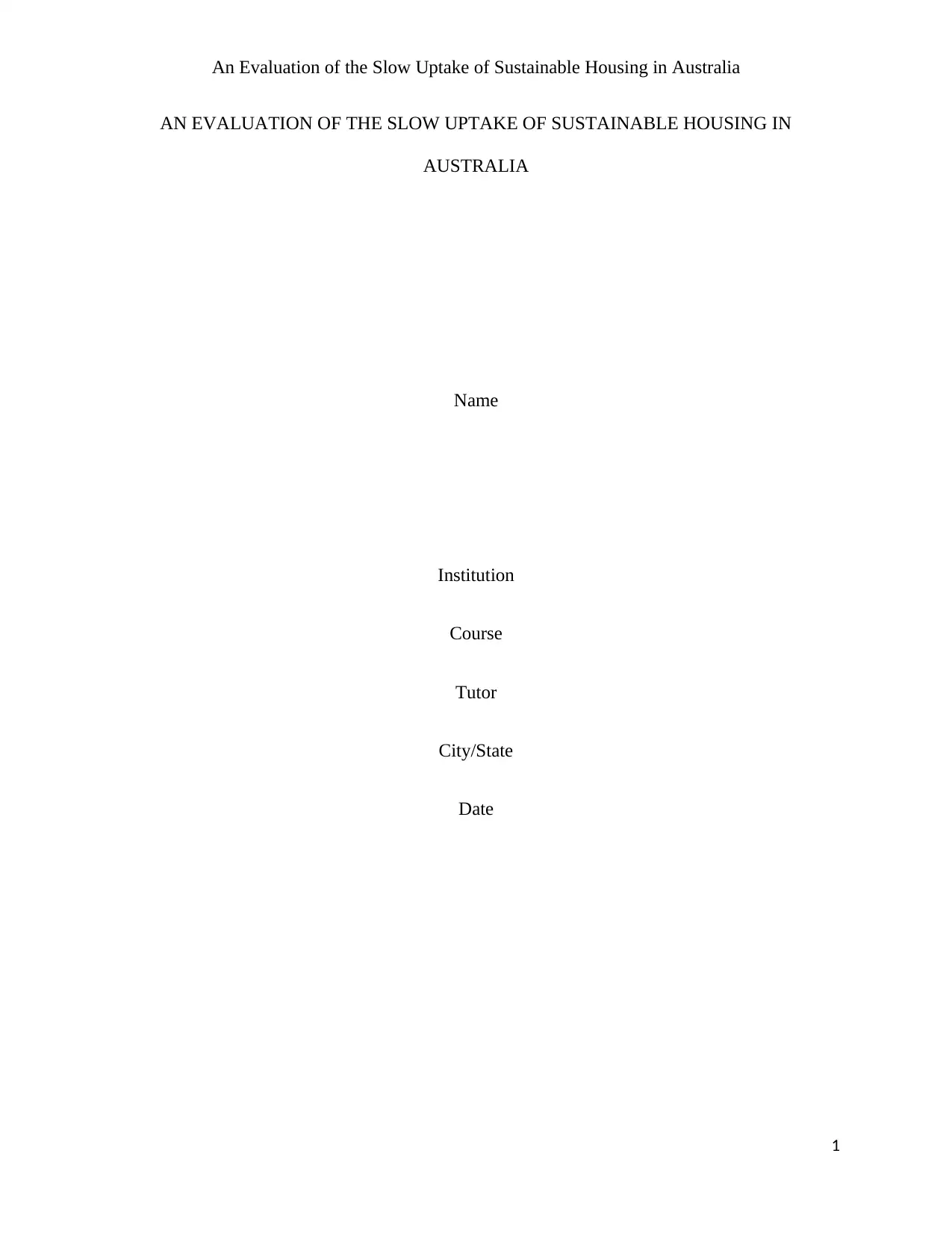
An Evaluation of the Slow Uptake of Sustainable Housing in Australia
AN EVALUATION OF THE SLOW UPTAKE OF SUSTAINABLE HOUSING IN
AUSTRALIA
Name
Institution
Course
Tutor
City/State
Date
1
AN EVALUATION OF THE SLOW UPTAKE OF SUSTAINABLE HOUSING IN
AUSTRALIA
Name
Institution
Course
Tutor
City/State
Date
1
Secure Best Marks with AI Grader
Need help grading? Try our AI Grader for instant feedback on your assignments.
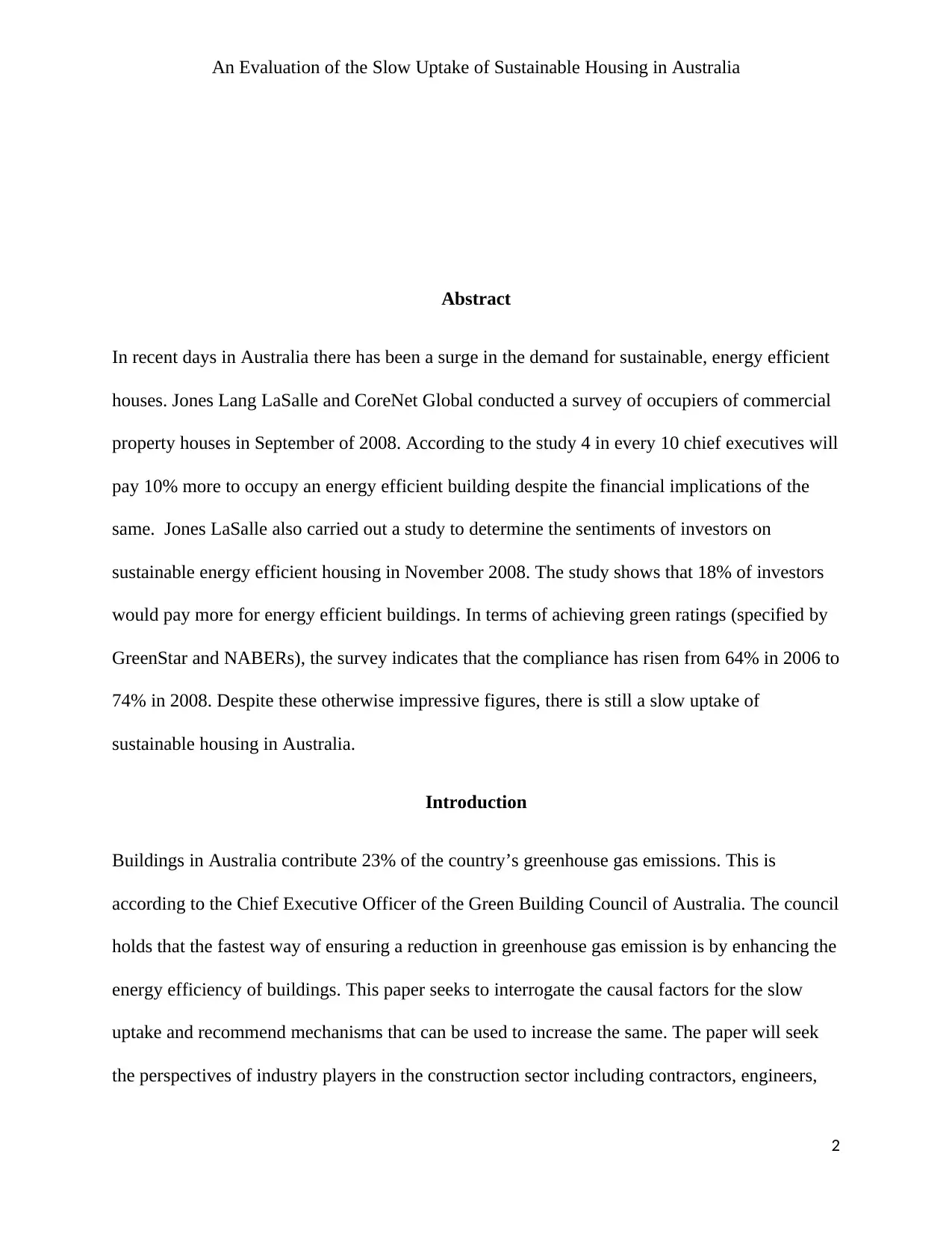
An Evaluation of the Slow Uptake of Sustainable Housing in Australia
Abstract
In recent days in Australia there has been a surge in the demand for sustainable, energy efficient
houses. Jones Lang LaSalle and CoreNet Global conducted a survey of occupiers of commercial
property houses in September of 2008. According to the study 4 in every 10 chief executives will
pay 10% more to occupy an energy efficient building despite the financial implications of the
same. Jones LaSalle also carried out a study to determine the sentiments of investors on
sustainable energy efficient housing in November 2008. The study shows that 18% of investors
would pay more for energy efficient buildings. In terms of achieving green ratings (specified by
GreenStar and NABERs), the survey indicates that the compliance has risen from 64% in 2006 to
74% in 2008. Despite these otherwise impressive figures, there is still a slow uptake of
sustainable housing in Australia.
Introduction
Buildings in Australia contribute 23% of the country’s greenhouse gas emissions. This is
according to the Chief Executive Officer of the Green Building Council of Australia. The council
holds that the fastest way of ensuring a reduction in greenhouse gas emission is by enhancing the
energy efficiency of buildings. This paper seeks to interrogate the causal factors for the slow
uptake and recommend mechanisms that can be used to increase the same. The paper will seek
the perspectives of industry players in the construction sector including contractors, engineers,
2
Abstract
In recent days in Australia there has been a surge in the demand for sustainable, energy efficient
houses. Jones Lang LaSalle and CoreNet Global conducted a survey of occupiers of commercial
property houses in September of 2008. According to the study 4 in every 10 chief executives will
pay 10% more to occupy an energy efficient building despite the financial implications of the
same. Jones LaSalle also carried out a study to determine the sentiments of investors on
sustainable energy efficient housing in November 2008. The study shows that 18% of investors
would pay more for energy efficient buildings. In terms of achieving green ratings (specified by
GreenStar and NABERs), the survey indicates that the compliance has risen from 64% in 2006 to
74% in 2008. Despite these otherwise impressive figures, there is still a slow uptake of
sustainable housing in Australia.
Introduction
Buildings in Australia contribute 23% of the country’s greenhouse gas emissions. This is
according to the Chief Executive Officer of the Green Building Council of Australia. The council
holds that the fastest way of ensuring a reduction in greenhouse gas emission is by enhancing the
energy efficiency of buildings. This paper seeks to interrogate the causal factors for the slow
uptake and recommend mechanisms that can be used to increase the same. The paper will seek
the perspectives of industry players in the construction sector including contractors, engineers,
2
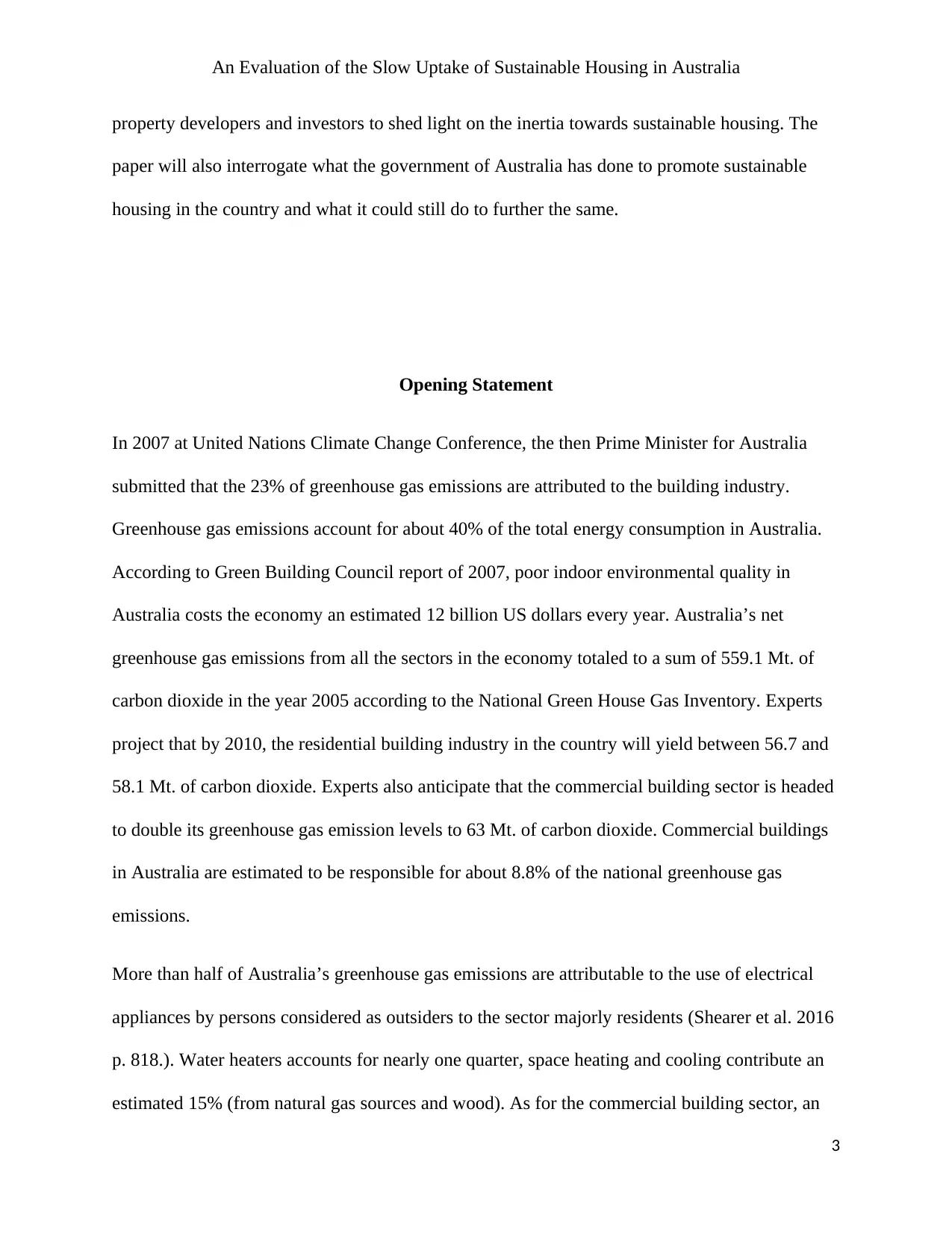
An Evaluation of the Slow Uptake of Sustainable Housing in Australia
property developers and investors to shed light on the inertia towards sustainable housing. The
paper will also interrogate what the government of Australia has done to promote sustainable
housing in the country and what it could still do to further the same.
Opening Statement
In 2007 at United Nations Climate Change Conference, the then Prime Minister for Australia
submitted that the 23% of greenhouse gas emissions are attributed to the building industry.
Greenhouse gas emissions account for about 40% of the total energy consumption in Australia.
According to Green Building Council report of 2007, poor indoor environmental quality in
Australia costs the economy an estimated 12 billion US dollars every year. Australia’s net
greenhouse gas emissions from all the sectors in the economy totaled to a sum of 559.1 Mt. of
carbon dioxide in the year 2005 according to the National Green House Gas Inventory. Experts
project that by 2010, the residential building industry in the country will yield between 56.7 and
58.1 Mt. of carbon dioxide. Experts also anticipate that the commercial building sector is headed
to double its greenhouse gas emission levels to 63 Mt. of carbon dioxide. Commercial buildings
in Australia are estimated to be responsible for about 8.8% of the national greenhouse gas
emissions.
More than half of Australia’s greenhouse gas emissions are attributable to the use of electrical
appliances by persons considered as outsiders to the sector majorly residents (Shearer et al. 2016
p. 818.). Water heaters accounts for nearly one quarter, space heating and cooling contribute an
estimated 15% (from natural gas sources and wood). As for the commercial building sector, an
3
property developers and investors to shed light on the inertia towards sustainable housing. The
paper will also interrogate what the government of Australia has done to promote sustainable
housing in the country and what it could still do to further the same.
Opening Statement
In 2007 at United Nations Climate Change Conference, the then Prime Minister for Australia
submitted that the 23% of greenhouse gas emissions are attributed to the building industry.
Greenhouse gas emissions account for about 40% of the total energy consumption in Australia.
According to Green Building Council report of 2007, poor indoor environmental quality in
Australia costs the economy an estimated 12 billion US dollars every year. Australia’s net
greenhouse gas emissions from all the sectors in the economy totaled to a sum of 559.1 Mt. of
carbon dioxide in the year 2005 according to the National Green House Gas Inventory. Experts
project that by 2010, the residential building industry in the country will yield between 56.7 and
58.1 Mt. of carbon dioxide. Experts also anticipate that the commercial building sector is headed
to double its greenhouse gas emission levels to 63 Mt. of carbon dioxide. Commercial buildings
in Australia are estimated to be responsible for about 8.8% of the national greenhouse gas
emissions.
More than half of Australia’s greenhouse gas emissions are attributable to the use of electrical
appliances by persons considered as outsiders to the sector majorly residents (Shearer et al. 2016
p. 818.). Water heaters accounts for nearly one quarter, space heating and cooling contribute an
estimated 15% (from natural gas sources and wood). As for the commercial building sector, an
3
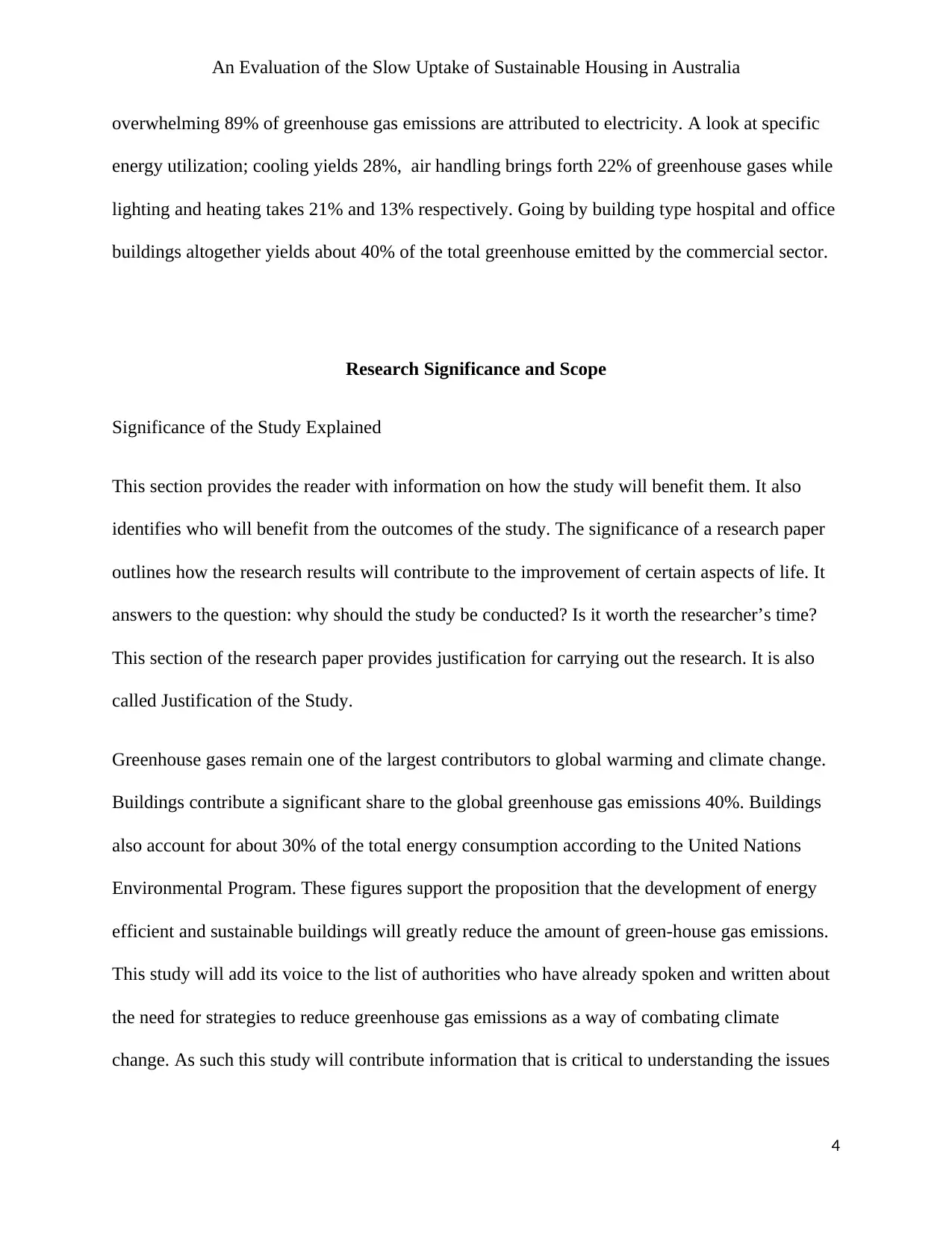
An Evaluation of the Slow Uptake of Sustainable Housing in Australia
overwhelming 89% of greenhouse gas emissions are attributed to electricity. A look at specific
energy utilization; cooling yields 28%, air handling brings forth 22% of greenhouse gases while
lighting and heating takes 21% and 13% respectively. Going by building type hospital and office
buildings altogether yields about 40% of the total greenhouse emitted by the commercial sector.
Research Significance and Scope
Significance of the Study Explained
This section provides the reader with information on how the study will benefit them. It also
identifies who will benefit from the outcomes of the study. The significance of a research paper
outlines how the research results will contribute to the improvement of certain aspects of life. It
answers to the question: why should the study be conducted? Is it worth the researcher’s time?
This section of the research paper provides justification for carrying out the research. It is also
called Justification of the Study.
Greenhouse gases remain one of the largest contributors to global warming and climate change.
Buildings contribute a significant share to the global greenhouse gas emissions 40%. Buildings
also account for about 30% of the total energy consumption according to the United Nations
Environmental Program. These figures support the proposition that the development of energy
efficient and sustainable buildings will greatly reduce the amount of green-house gas emissions.
This study will add its voice to the list of authorities who have already spoken and written about
the need for strategies to reduce greenhouse gas emissions as a way of combating climate
change. As such this study will contribute information that is critical to understanding the issues
4
overwhelming 89% of greenhouse gas emissions are attributed to electricity. A look at specific
energy utilization; cooling yields 28%, air handling brings forth 22% of greenhouse gases while
lighting and heating takes 21% and 13% respectively. Going by building type hospital and office
buildings altogether yields about 40% of the total greenhouse emitted by the commercial sector.
Research Significance and Scope
Significance of the Study Explained
This section provides the reader with information on how the study will benefit them. It also
identifies who will benefit from the outcomes of the study. The significance of a research paper
outlines how the research results will contribute to the improvement of certain aspects of life. It
answers to the question: why should the study be conducted? Is it worth the researcher’s time?
This section of the research paper provides justification for carrying out the research. It is also
called Justification of the Study.
Greenhouse gases remain one of the largest contributors to global warming and climate change.
Buildings contribute a significant share to the global greenhouse gas emissions 40%. Buildings
also account for about 30% of the total energy consumption according to the United Nations
Environmental Program. These figures support the proposition that the development of energy
efficient and sustainable buildings will greatly reduce the amount of green-house gas emissions.
This study will add its voice to the list of authorities who have already spoken and written about
the need for strategies to reduce greenhouse gas emissions as a way of combating climate
change. As such this study will contribute information that is critical to understanding the issues
4
Secure Best Marks with AI Grader
Need help grading? Try our AI Grader for instant feedback on your assignments.
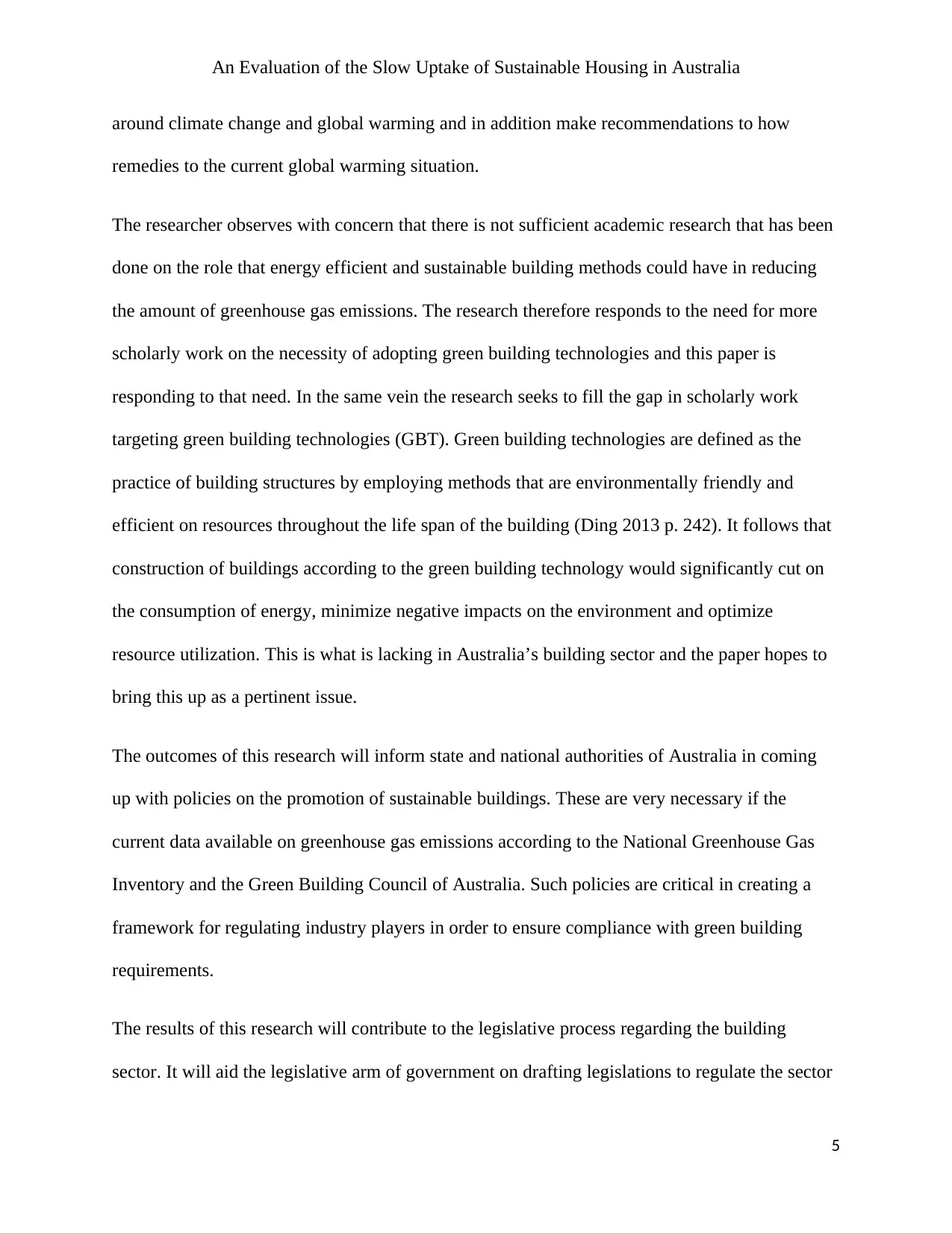
An Evaluation of the Slow Uptake of Sustainable Housing in Australia
around climate change and global warming and in addition make recommendations to how
remedies to the current global warming situation.
The researcher observes with concern that there is not sufficient academic research that has been
done on the role that energy efficient and sustainable building methods could have in reducing
the amount of greenhouse gas emissions. The research therefore responds to the need for more
scholarly work on the necessity of adopting green building technologies and this paper is
responding to that need. In the same vein the research seeks to fill the gap in scholarly work
targeting green building technologies (GBT). Green building technologies are defined as the
practice of building structures by employing methods that are environmentally friendly and
efficient on resources throughout the life span of the building (Ding 2013 p. 242). It follows that
construction of buildings according to the green building technology would significantly cut on
the consumption of energy, minimize negative impacts on the environment and optimize
resource utilization. This is what is lacking in Australia’s building sector and the paper hopes to
bring this up as a pertinent issue.
The outcomes of this research will inform state and national authorities of Australia in coming
up with policies on the promotion of sustainable buildings. These are very necessary if the
current data available on greenhouse gas emissions according to the National Greenhouse Gas
Inventory and the Green Building Council of Australia. Such policies are critical in creating a
framework for regulating industry players in order to ensure compliance with green building
requirements.
The results of this research will contribute to the legislative process regarding the building
sector. It will aid the legislative arm of government on drafting legislations to regulate the sector
5
around climate change and global warming and in addition make recommendations to how
remedies to the current global warming situation.
The researcher observes with concern that there is not sufficient academic research that has been
done on the role that energy efficient and sustainable building methods could have in reducing
the amount of greenhouse gas emissions. The research therefore responds to the need for more
scholarly work on the necessity of adopting green building technologies and this paper is
responding to that need. In the same vein the research seeks to fill the gap in scholarly work
targeting green building technologies (GBT). Green building technologies are defined as the
practice of building structures by employing methods that are environmentally friendly and
efficient on resources throughout the life span of the building (Ding 2013 p. 242). It follows that
construction of buildings according to the green building technology would significantly cut on
the consumption of energy, minimize negative impacts on the environment and optimize
resource utilization. This is what is lacking in Australia’s building sector and the paper hopes to
bring this up as a pertinent issue.
The outcomes of this research will inform state and national authorities of Australia in coming
up with policies on the promotion of sustainable buildings. These are very necessary if the
current data available on greenhouse gas emissions according to the National Greenhouse Gas
Inventory and the Green Building Council of Australia. Such policies are critical in creating a
framework for regulating industry players in order to ensure compliance with green building
requirements.
The results of this research will contribute to the legislative process regarding the building
sector. It will aid the legislative arm of government on drafting legislations to regulate the sector
5
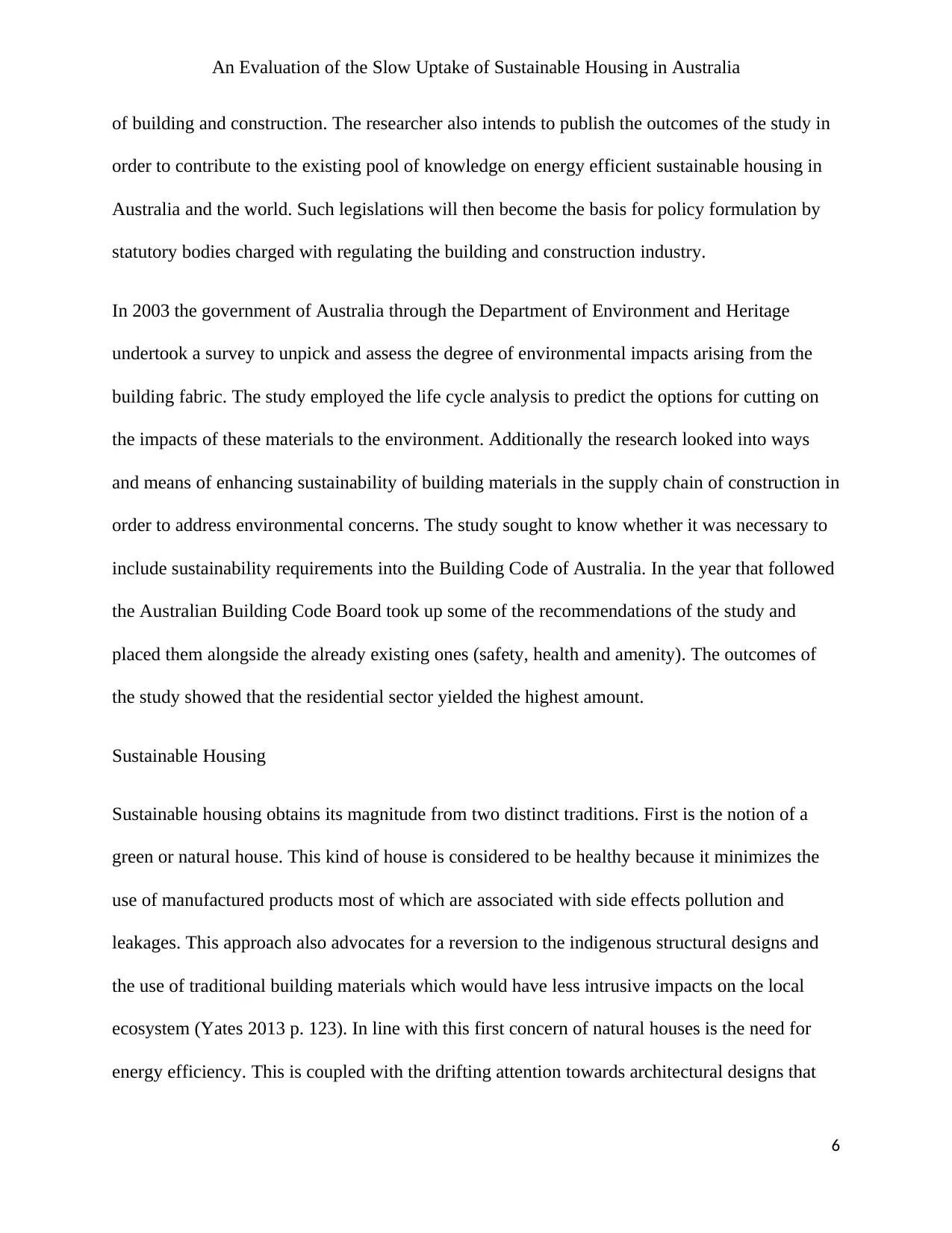
An Evaluation of the Slow Uptake of Sustainable Housing in Australia
of building and construction. The researcher also intends to publish the outcomes of the study in
order to contribute to the existing pool of knowledge on energy efficient sustainable housing in
Australia and the world. Such legislations will then become the basis for policy formulation by
statutory bodies charged with regulating the building and construction industry.
In 2003 the government of Australia through the Department of Environment and Heritage
undertook a survey to unpick and assess the degree of environmental impacts arising from the
building fabric. The study employed the life cycle analysis to predict the options for cutting on
the impacts of these materials to the environment. Additionally the research looked into ways
and means of enhancing sustainability of building materials in the supply chain of construction in
order to address environmental concerns. The study sought to know whether it was necessary to
include sustainability requirements into the Building Code of Australia. In the year that followed
the Australian Building Code Board took up some of the recommendations of the study and
placed them alongside the already existing ones (safety, health and amenity). The outcomes of
the study showed that the residential sector yielded the highest amount.
Sustainable Housing
Sustainable housing obtains its magnitude from two distinct traditions. First is the notion of a
green or natural house. This kind of house is considered to be healthy because it minimizes the
use of manufactured products most of which are associated with side effects pollution and
leakages. This approach also advocates for a reversion to the indigenous structural designs and
the use of traditional building materials which would have less intrusive impacts on the local
ecosystem (Yates 2013 p. 123). In line with this first concern of natural houses is the need for
energy efficiency. This is coupled with the drifting attention towards architectural designs that
6
of building and construction. The researcher also intends to publish the outcomes of the study in
order to contribute to the existing pool of knowledge on energy efficient sustainable housing in
Australia and the world. Such legislations will then become the basis for policy formulation by
statutory bodies charged with regulating the building and construction industry.
In 2003 the government of Australia through the Department of Environment and Heritage
undertook a survey to unpick and assess the degree of environmental impacts arising from the
building fabric. The study employed the life cycle analysis to predict the options for cutting on
the impacts of these materials to the environment. Additionally the research looked into ways
and means of enhancing sustainability of building materials in the supply chain of construction in
order to address environmental concerns. The study sought to know whether it was necessary to
include sustainability requirements into the Building Code of Australia. In the year that followed
the Australian Building Code Board took up some of the recommendations of the study and
placed them alongside the already existing ones (safety, health and amenity). The outcomes of
the study showed that the residential sector yielded the highest amount.
Sustainable Housing
Sustainable housing obtains its magnitude from two distinct traditions. First is the notion of a
green or natural house. This kind of house is considered to be healthy because it minimizes the
use of manufactured products most of which are associated with side effects pollution and
leakages. This approach also advocates for a reversion to the indigenous structural designs and
the use of traditional building materials which would have less intrusive impacts on the local
ecosystem (Yates 2013 p. 123). In line with this first concern of natural houses is the need for
energy efficiency. This is coupled with the drifting attention towards architectural designs that
6
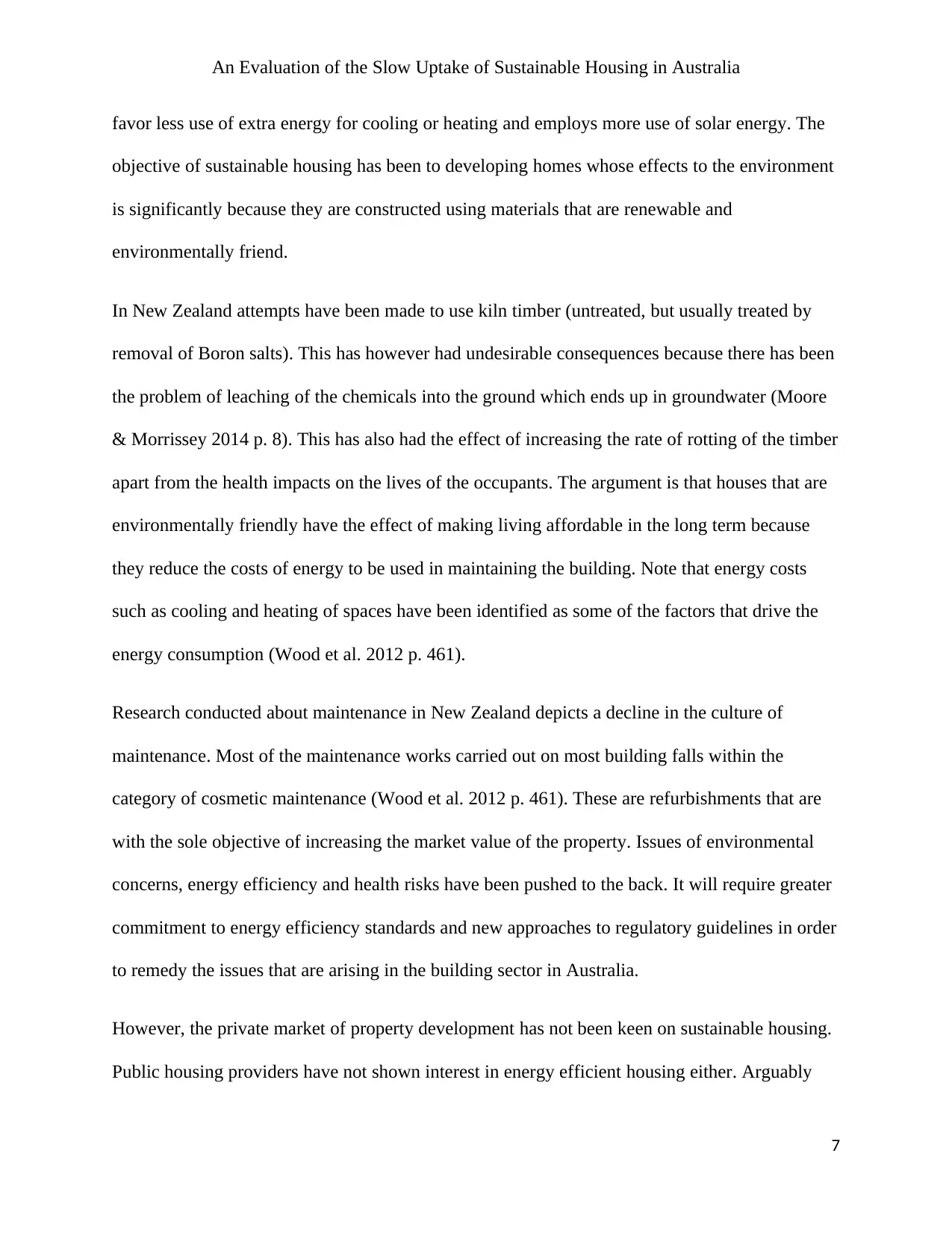
An Evaluation of the Slow Uptake of Sustainable Housing in Australia
favor less use of extra energy for cooling or heating and employs more use of solar energy. The
objective of sustainable housing has been to developing homes whose effects to the environment
is significantly because they are constructed using materials that are renewable and
environmentally friend.
In New Zealand attempts have been made to use kiln timber (untreated, but usually treated by
removal of Boron salts). This has however had undesirable consequences because there has been
the problem of leaching of the chemicals into the ground which ends up in groundwater (Moore
& Morrissey 2014 p. 8). This has also had the effect of increasing the rate of rotting of the timber
apart from the health impacts on the lives of the occupants. The argument is that houses that are
environmentally friendly have the effect of making living affordable in the long term because
they reduce the costs of energy to be used in maintaining the building. Note that energy costs
such as cooling and heating of spaces have been identified as some of the factors that drive the
energy consumption (Wood et al. 2012 p. 461).
Research conducted about maintenance in New Zealand depicts a decline in the culture of
maintenance. Most of the maintenance works carried out on most building falls within the
category of cosmetic maintenance (Wood et al. 2012 p. 461). These are refurbishments that are
with the sole objective of increasing the market value of the property. Issues of environmental
concerns, energy efficiency and health risks have been pushed to the back. It will require greater
commitment to energy efficiency standards and new approaches to regulatory guidelines in order
to remedy the issues that are arising in the building sector in Australia.
However, the private market of property development has not been keen on sustainable housing.
Public housing providers have not shown interest in energy efficient housing either. Arguably
7
favor less use of extra energy for cooling or heating and employs more use of solar energy. The
objective of sustainable housing has been to developing homes whose effects to the environment
is significantly because they are constructed using materials that are renewable and
environmentally friend.
In New Zealand attempts have been made to use kiln timber (untreated, but usually treated by
removal of Boron salts). This has however had undesirable consequences because there has been
the problem of leaching of the chemicals into the ground which ends up in groundwater (Moore
& Morrissey 2014 p. 8). This has also had the effect of increasing the rate of rotting of the timber
apart from the health impacts on the lives of the occupants. The argument is that houses that are
environmentally friendly have the effect of making living affordable in the long term because
they reduce the costs of energy to be used in maintaining the building. Note that energy costs
such as cooling and heating of spaces have been identified as some of the factors that drive the
energy consumption (Wood et al. 2012 p. 461).
Research conducted about maintenance in New Zealand depicts a decline in the culture of
maintenance. Most of the maintenance works carried out on most building falls within the
category of cosmetic maintenance (Wood et al. 2012 p. 461). These are refurbishments that are
with the sole objective of increasing the market value of the property. Issues of environmental
concerns, energy efficiency and health risks have been pushed to the back. It will require greater
commitment to energy efficiency standards and new approaches to regulatory guidelines in order
to remedy the issues that are arising in the building sector in Australia.
However, the private market of property development has not been keen on sustainable housing.
Public housing providers have not shown interest in energy efficient housing either. Arguably
7
Paraphrase This Document
Need a fresh take? Get an instant paraphrase of this document with our AI Paraphraser
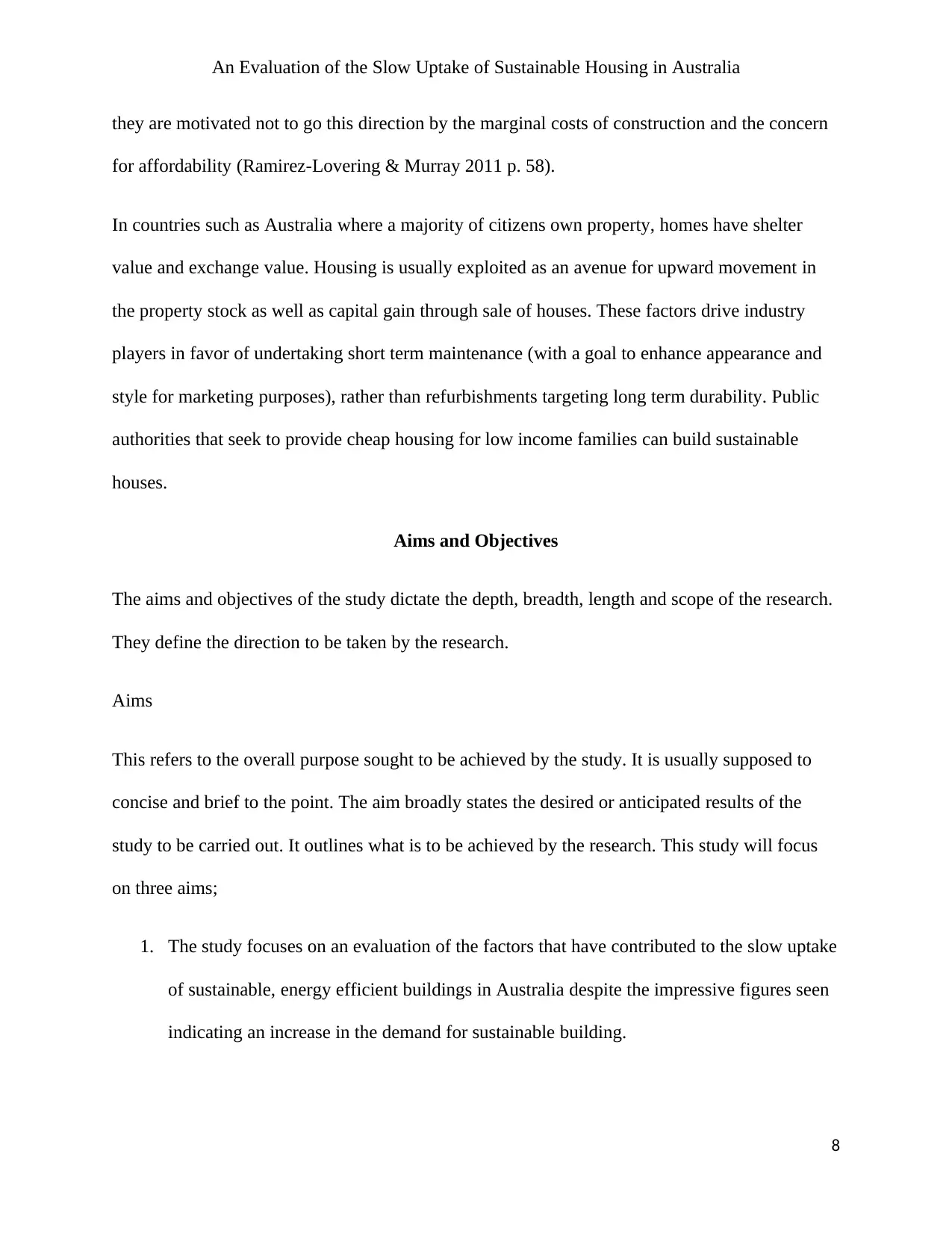
An Evaluation of the Slow Uptake of Sustainable Housing in Australia
they are motivated not to go this direction by the marginal costs of construction and the concern
for affordability (Ramirez-Lovering & Murray 2011 p. 58).
In countries such as Australia where a majority of citizens own property, homes have shelter
value and exchange value. Housing is usually exploited as an avenue for upward movement in
the property stock as well as capital gain through sale of houses. These factors drive industry
players in favor of undertaking short term maintenance (with a goal to enhance appearance and
style for marketing purposes), rather than refurbishments targeting long term durability. Public
authorities that seek to provide cheap housing for low income families can build sustainable
houses.
Aims and Objectives
The aims and objectives of the study dictate the depth, breadth, length and scope of the research.
They define the direction to be taken by the research.
Aims
This refers to the overall purpose sought to be achieved by the study. It is usually supposed to
concise and brief to the point. The aim broadly states the desired or anticipated results of the
study to be carried out. It outlines what is to be achieved by the research. This study will focus
on three aims;
1. The study focuses on an evaluation of the factors that have contributed to the slow uptake
of sustainable, energy efficient buildings in Australia despite the impressive figures seen
indicating an increase in the demand for sustainable building.
8
they are motivated not to go this direction by the marginal costs of construction and the concern
for affordability (Ramirez-Lovering & Murray 2011 p. 58).
In countries such as Australia where a majority of citizens own property, homes have shelter
value and exchange value. Housing is usually exploited as an avenue for upward movement in
the property stock as well as capital gain through sale of houses. These factors drive industry
players in favor of undertaking short term maintenance (with a goal to enhance appearance and
style for marketing purposes), rather than refurbishments targeting long term durability. Public
authorities that seek to provide cheap housing for low income families can build sustainable
houses.
Aims and Objectives
The aims and objectives of the study dictate the depth, breadth, length and scope of the research.
They define the direction to be taken by the research.
Aims
This refers to the overall purpose sought to be achieved by the study. It is usually supposed to
concise and brief to the point. The aim broadly states the desired or anticipated results of the
study to be carried out. It outlines what is to be achieved by the research. This study will focus
on three aims;
1. The study focuses on an evaluation of the factors that have contributed to the slow uptake
of sustainable, energy efficient buildings in Australia despite the impressive figures seen
indicating an increase in the demand for sustainable building.
8
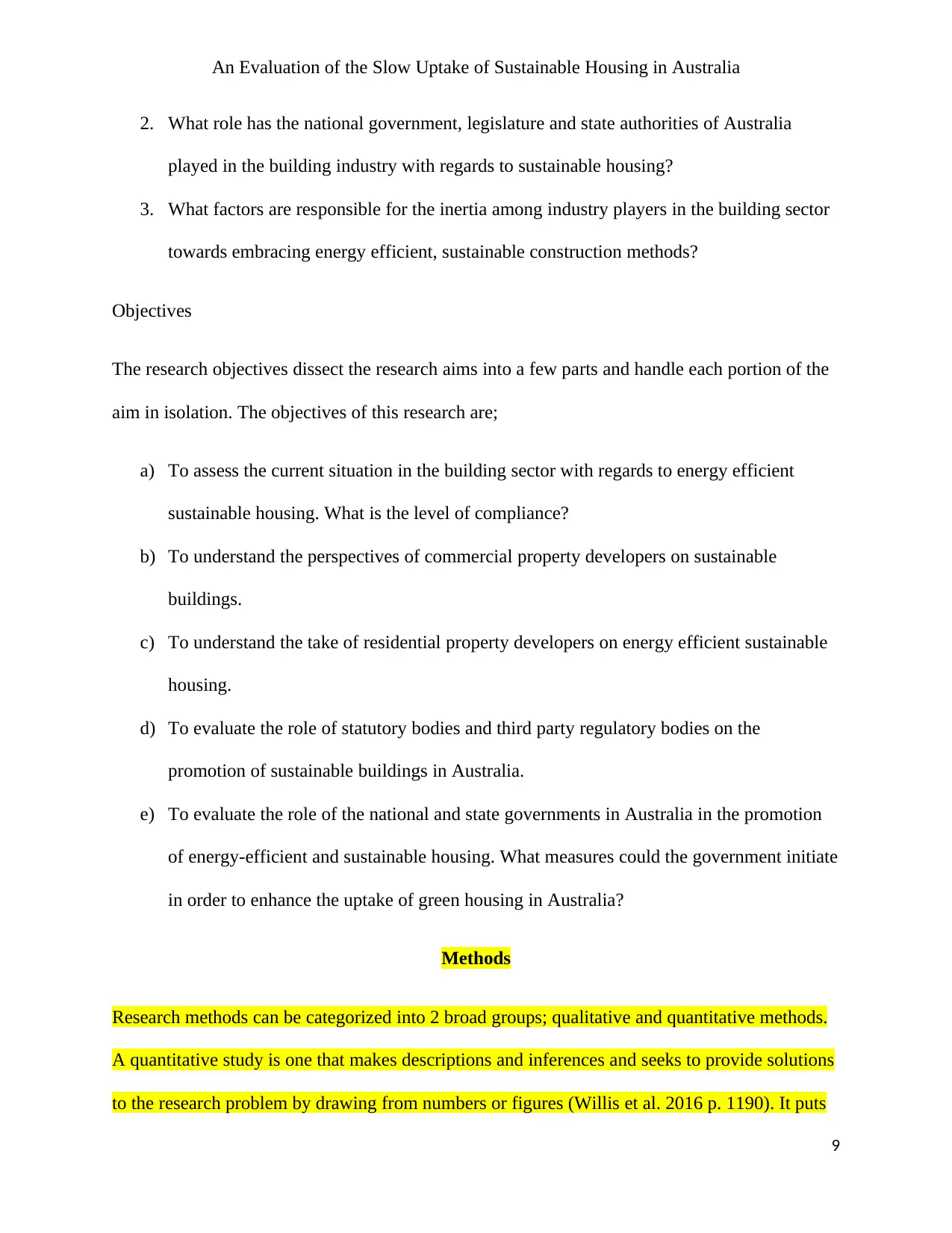
An Evaluation of the Slow Uptake of Sustainable Housing in Australia
2. What role has the national government, legislature and state authorities of Australia
played in the building industry with regards to sustainable housing?
3. What factors are responsible for the inertia among industry players in the building sector
towards embracing energy efficient, sustainable construction methods?
Objectives
The research objectives dissect the research aims into a few parts and handle each portion of the
aim in isolation. The objectives of this research are;
a) To assess the current situation in the building sector with regards to energy efficient
sustainable housing. What is the level of compliance?
b) To understand the perspectives of commercial property developers on sustainable
buildings.
c) To understand the take of residential property developers on energy efficient sustainable
housing.
d) To evaluate the role of statutory bodies and third party regulatory bodies on the
promotion of sustainable buildings in Australia.
e) To evaluate the role of the national and state governments in Australia in the promotion
of energy-efficient and sustainable housing. What measures could the government initiate
in order to enhance the uptake of green housing in Australia?
Methods
Research methods can be categorized into 2 broad groups; qualitative and quantitative methods.
A quantitative study is one that makes descriptions and inferences and seeks to provide solutions
to the research problem by drawing from numbers or figures (Willis et al. 2016 p. 1190). It puts
9
2. What role has the national government, legislature and state authorities of Australia
played in the building industry with regards to sustainable housing?
3. What factors are responsible for the inertia among industry players in the building sector
towards embracing energy efficient, sustainable construction methods?
Objectives
The research objectives dissect the research aims into a few parts and handle each portion of the
aim in isolation. The objectives of this research are;
a) To assess the current situation in the building sector with regards to energy efficient
sustainable housing. What is the level of compliance?
b) To understand the perspectives of commercial property developers on sustainable
buildings.
c) To understand the take of residential property developers on energy efficient sustainable
housing.
d) To evaluate the role of statutory bodies and third party regulatory bodies on the
promotion of sustainable buildings in Australia.
e) To evaluate the role of the national and state governments in Australia in the promotion
of energy-efficient and sustainable housing. What measures could the government initiate
in order to enhance the uptake of green housing in Australia?
Methods
Research methods can be categorized into 2 broad groups; qualitative and quantitative methods.
A quantitative study is one that makes descriptions and inferences and seeks to provide solutions
to the research problem by drawing from numbers or figures (Willis et al. 2016 p. 1190). It puts
9
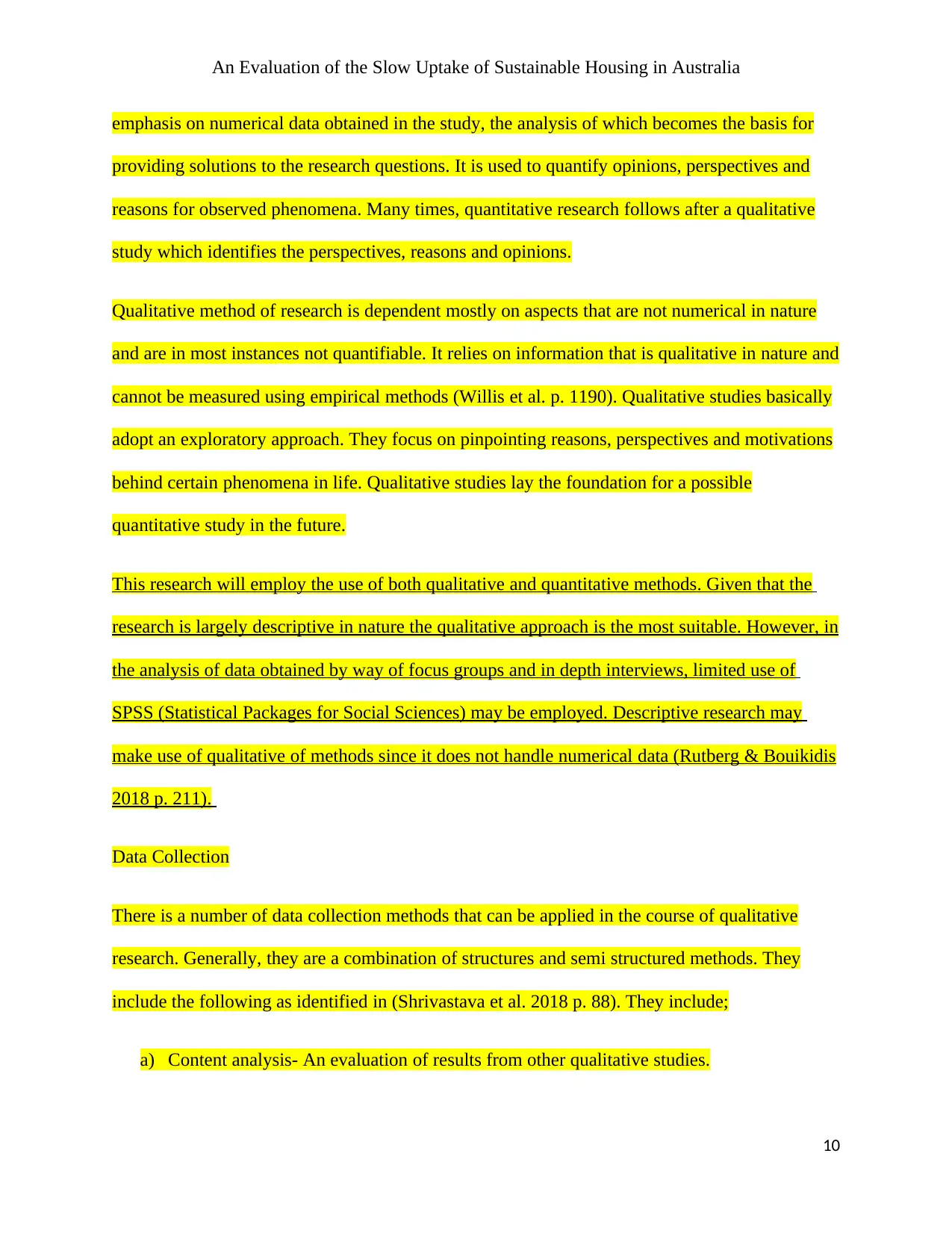
An Evaluation of the Slow Uptake of Sustainable Housing in Australia
emphasis on numerical data obtained in the study, the analysis of which becomes the basis for
providing solutions to the research questions. It is used to quantify opinions, perspectives and
reasons for observed phenomena. Many times, quantitative research follows after a qualitative
study which identifies the perspectives, reasons and opinions.
Qualitative method of research is dependent mostly on aspects that are not numerical in nature
and are in most instances not quantifiable. It relies on information that is qualitative in nature and
cannot be measured using empirical methods (Willis et al. p. 1190). Qualitative studies basically
adopt an exploratory approach. They focus on pinpointing reasons, perspectives and motivations
behind certain phenomena in life. Qualitative studies lay the foundation for a possible
quantitative study in the future.
This research will employ the use of both qualitative and quantitative methods. Given that the
research is largely descriptive in nature the qualitative approach is the most suitable. However, in
the analysis of data obtained by way of focus groups and in depth interviews, limited use of
SPSS (Statistical Packages for Social Sciences) may be employed. Descriptive research may
make use of qualitative of methods since it does not handle numerical data (Rutberg & Bouikidis
2018 p. 211).
Data Collection
There is a number of data collection methods that can be applied in the course of qualitative
research. Generally, they are a combination of structures and semi structured methods. They
include the following as identified in (Shrivastava et al. 2018 p. 88). They include;
a) Content analysis- An evaluation of results from other qualitative studies.
10
emphasis on numerical data obtained in the study, the analysis of which becomes the basis for
providing solutions to the research questions. It is used to quantify opinions, perspectives and
reasons for observed phenomena. Many times, quantitative research follows after a qualitative
study which identifies the perspectives, reasons and opinions.
Qualitative method of research is dependent mostly on aspects that are not numerical in nature
and are in most instances not quantifiable. It relies on information that is qualitative in nature and
cannot be measured using empirical methods (Willis et al. p. 1190). Qualitative studies basically
adopt an exploratory approach. They focus on pinpointing reasons, perspectives and motivations
behind certain phenomena in life. Qualitative studies lay the foundation for a possible
quantitative study in the future.
This research will employ the use of both qualitative and quantitative methods. Given that the
research is largely descriptive in nature the qualitative approach is the most suitable. However, in
the analysis of data obtained by way of focus groups and in depth interviews, limited use of
SPSS (Statistical Packages for Social Sciences) may be employed. Descriptive research may
make use of qualitative of methods since it does not handle numerical data (Rutberg & Bouikidis
2018 p. 211).
Data Collection
There is a number of data collection methods that can be applied in the course of qualitative
research. Generally, they are a combination of structures and semi structured methods. They
include the following as identified in (Shrivastava et al. 2018 p. 88). They include;
a) Content analysis- An evaluation of results from other qualitative studies.
10
Secure Best Marks with AI Grader
Need help grading? Try our AI Grader for instant feedback on your assignments.
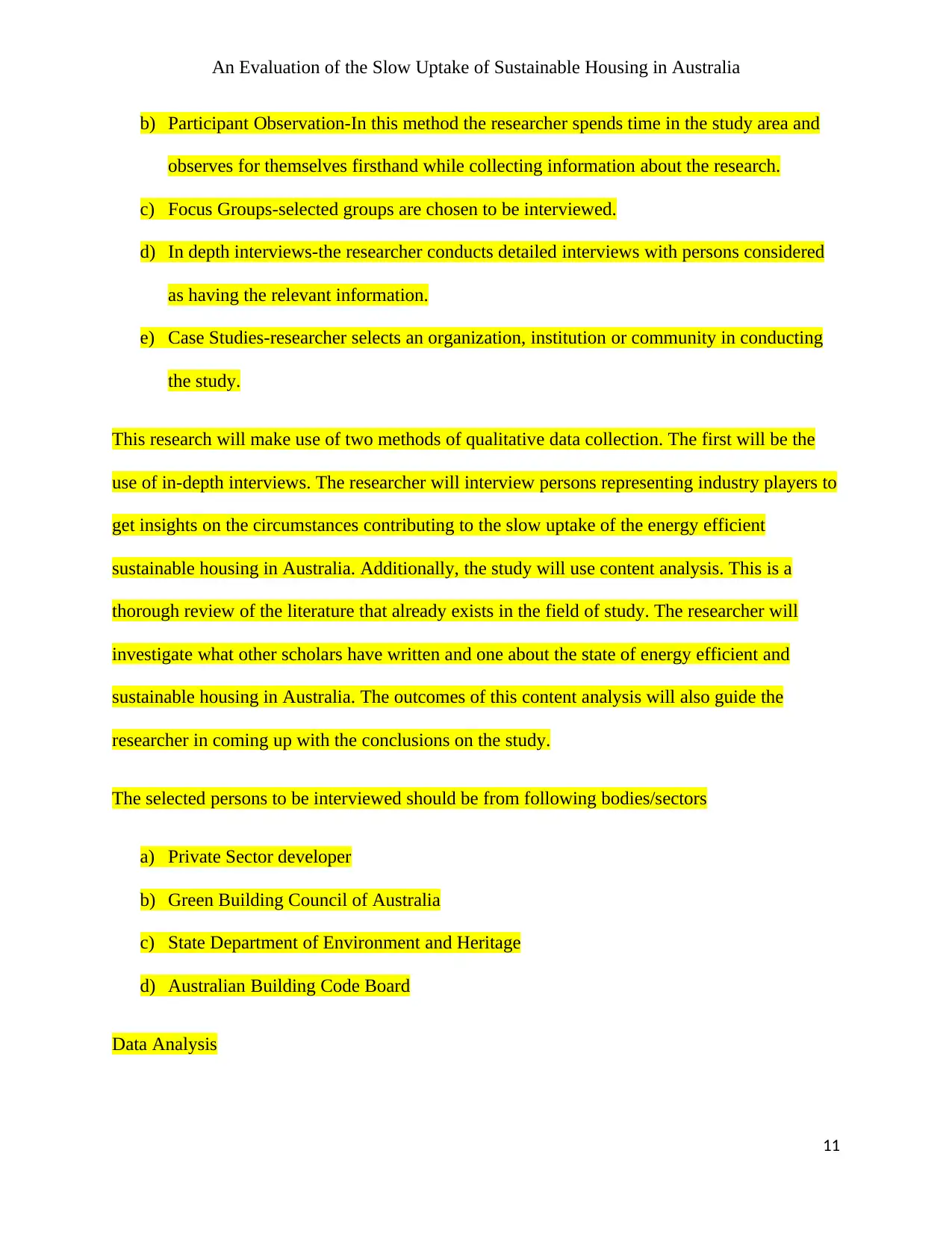
An Evaluation of the Slow Uptake of Sustainable Housing in Australia
b) Participant Observation-In this method the researcher spends time in the study area and
observes for themselves firsthand while collecting information about the research.
c) Focus Groups-selected groups are chosen to be interviewed.
d) In depth interviews-the researcher conducts detailed interviews with persons considered
as having the relevant information.
e) Case Studies-researcher selects an organization, institution or community in conducting
the study.
This research will make use of two methods of qualitative data collection. The first will be the
use of in-depth interviews. The researcher will interview persons representing industry players to
get insights on the circumstances contributing to the slow uptake of the energy efficient
sustainable housing in Australia. Additionally, the study will use content analysis. This is a
thorough review of the literature that already exists in the field of study. The researcher will
investigate what other scholars have written and one about the state of energy efficient and
sustainable housing in Australia. The outcomes of this content analysis will also guide the
researcher in coming up with the conclusions on the study.
The selected persons to be interviewed should be from following bodies/sectors
a) Private Sector developer
b) Green Building Council of Australia
c) State Department of Environment and Heritage
d) Australian Building Code Board
Data Analysis
11
b) Participant Observation-In this method the researcher spends time in the study area and
observes for themselves firsthand while collecting information about the research.
c) Focus Groups-selected groups are chosen to be interviewed.
d) In depth interviews-the researcher conducts detailed interviews with persons considered
as having the relevant information.
e) Case Studies-researcher selects an organization, institution or community in conducting
the study.
This research will make use of two methods of qualitative data collection. The first will be the
use of in-depth interviews. The researcher will interview persons representing industry players to
get insights on the circumstances contributing to the slow uptake of the energy efficient
sustainable housing in Australia. Additionally, the study will use content analysis. This is a
thorough review of the literature that already exists in the field of study. The researcher will
investigate what other scholars have written and one about the state of energy efficient and
sustainable housing in Australia. The outcomes of this content analysis will also guide the
researcher in coming up with the conclusions on the study.
The selected persons to be interviewed should be from following bodies/sectors
a) Private Sector developer
b) Green Building Council of Australia
c) State Department of Environment and Heritage
d) Australian Building Code Board
Data Analysis
11
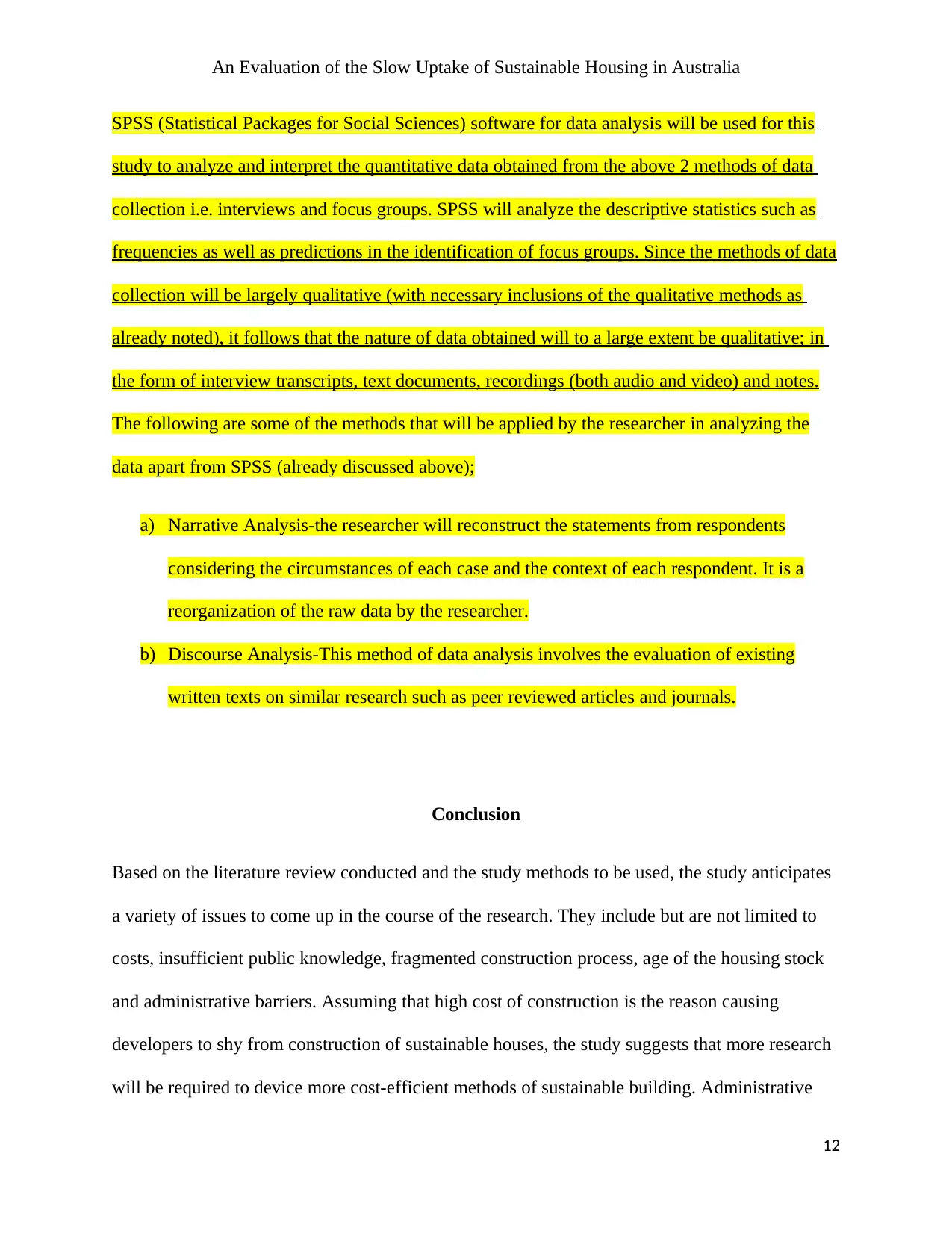
An Evaluation of the Slow Uptake of Sustainable Housing in Australia
SPSS (Statistical Packages for Social Sciences) software for data analysis will be used for this
study to analyze and interpret the quantitative data obtained from the above 2 methods of data
collection i.e. interviews and focus groups. SPSS will analyze the descriptive statistics such as
frequencies as well as predictions in the identification of focus groups. Since the methods of data
collection will be largely qualitative (with necessary inclusions of the qualitative methods as
already noted), it follows that the nature of data obtained will to a large extent be qualitative; in
the form of interview transcripts, text documents, recordings (both audio and video) and notes.
The following are some of the methods that will be applied by the researcher in analyzing the
data apart from SPSS (already discussed above);
a) Narrative Analysis-the researcher will reconstruct the statements from respondents
considering the circumstances of each case and the context of each respondent. It is a
reorganization of the raw data by the researcher.
b) Discourse Analysis-This method of data analysis involves the evaluation of existing
written texts on similar research such as peer reviewed articles and journals.
Conclusion
Based on the literature review conducted and the study methods to be used, the study anticipates
a variety of issues to come up in the course of the research. They include but are not limited to
costs, insufficient public knowledge, fragmented construction process, age of the housing stock
and administrative barriers. Assuming that high cost of construction is the reason causing
developers to shy from construction of sustainable houses, the study suggests that more research
will be required to device more cost-efficient methods of sustainable building. Administrative
12
SPSS (Statistical Packages for Social Sciences) software for data analysis will be used for this
study to analyze and interpret the quantitative data obtained from the above 2 methods of data
collection i.e. interviews and focus groups. SPSS will analyze the descriptive statistics such as
frequencies as well as predictions in the identification of focus groups. Since the methods of data
collection will be largely qualitative (with necessary inclusions of the qualitative methods as
already noted), it follows that the nature of data obtained will to a large extent be qualitative; in
the form of interview transcripts, text documents, recordings (both audio and video) and notes.
The following are some of the methods that will be applied by the researcher in analyzing the
data apart from SPSS (already discussed above);
a) Narrative Analysis-the researcher will reconstruct the statements from respondents
considering the circumstances of each case and the context of each respondent. It is a
reorganization of the raw data by the researcher.
b) Discourse Analysis-This method of data analysis involves the evaluation of existing
written texts on similar research such as peer reviewed articles and journals.
Conclusion
Based on the literature review conducted and the study methods to be used, the study anticipates
a variety of issues to come up in the course of the research. They include but are not limited to
costs, insufficient public knowledge, fragmented construction process, age of the housing stock
and administrative barriers. Assuming that high cost of construction is the reason causing
developers to shy from construction of sustainable houses, the study suggests that more research
will be required to device more cost-efficient methods of sustainable building. Administrative
12
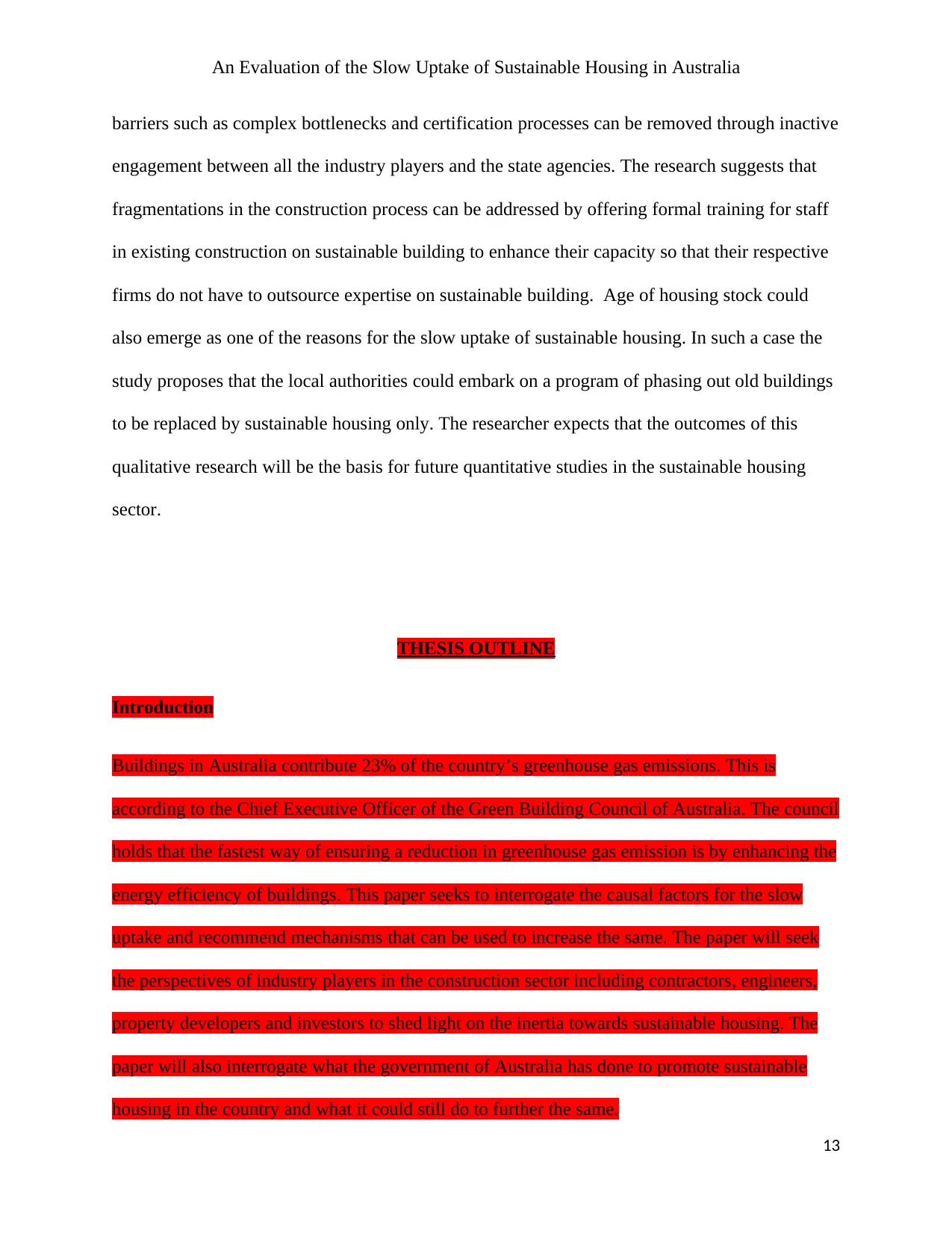
An Evaluation of the Slow Uptake of Sustainable Housing in Australia
barriers such as complex bottlenecks and certification processes can be removed through inactive
engagement between all the industry players and the state agencies. The research suggests that
fragmentations in the construction process can be addressed by offering formal training for staff
in existing construction on sustainable building to enhance their capacity so that their respective
firms do not have to outsource expertise on sustainable building. Age of housing stock could
also emerge as one of the reasons for the slow uptake of sustainable housing. In such a case the
study proposes that the local authorities could embark on a program of phasing out old buildings
to be replaced by sustainable housing only. The researcher expects that the outcomes of this
qualitative research will be the basis for future quantitative studies in the sustainable housing
sector.
THESIS OUTLINE
Introduction
Buildings in Australia contribute 23% of the country’s greenhouse gas emissions. This is
according to the Chief Executive Officer of the Green Building Council of Australia. The council
holds that the fastest way of ensuring a reduction in greenhouse gas emission is by enhancing the
energy efficiency of buildings. This paper seeks to interrogate the causal factors for the slow
uptake and recommend mechanisms that can be used to increase the same. The paper will seek
the perspectives of industry players in the construction sector including contractors, engineers,
property developers and investors to shed light on the inertia towards sustainable housing. The
paper will also interrogate what the government of Australia has done to promote sustainable
housing in the country and what it could still do to further the same.
13
barriers such as complex bottlenecks and certification processes can be removed through inactive
engagement between all the industry players and the state agencies. The research suggests that
fragmentations in the construction process can be addressed by offering formal training for staff
in existing construction on sustainable building to enhance their capacity so that their respective
firms do not have to outsource expertise on sustainable building. Age of housing stock could
also emerge as one of the reasons for the slow uptake of sustainable housing. In such a case the
study proposes that the local authorities could embark on a program of phasing out old buildings
to be replaced by sustainable housing only. The researcher expects that the outcomes of this
qualitative research will be the basis for future quantitative studies in the sustainable housing
sector.
THESIS OUTLINE
Introduction
Buildings in Australia contribute 23% of the country’s greenhouse gas emissions. This is
according to the Chief Executive Officer of the Green Building Council of Australia. The council
holds that the fastest way of ensuring a reduction in greenhouse gas emission is by enhancing the
energy efficiency of buildings. This paper seeks to interrogate the causal factors for the slow
uptake and recommend mechanisms that can be used to increase the same. The paper will seek
the perspectives of industry players in the construction sector including contractors, engineers,
property developers and investors to shed light on the inertia towards sustainable housing. The
paper will also interrogate what the government of Australia has done to promote sustainable
housing in the country and what it could still do to further the same.
13
Paraphrase This Document
Need a fresh take? Get an instant paraphrase of this document with our AI Paraphraser

An Evaluation of the Slow Uptake of Sustainable Housing in Australia
What constitute low income housing?
More than half of Australia’s greenhouse gas emissions are attributable to the use of electrical
appliances by persons considered as outsiders to the sector majorly residents. Water heaters
accounts for nearly one quarter, space heating and cooling contribute an estimated 15% (from
natural gas sources and wood). As for the commercial building sector, an overwhelming 89% of
greenhouse gas emissions are attributed to electricity. A look at specific energy utilization;
cooling yields 28%, air handling brings forth 22% of greenhouse gases while lighting and
heating takes 21% and 13% respectively. Going by building type hospital and office buildings
altogether yields about 40% of the total greenhouse emitted by the commercial sector.
Problem statement
The researcher observes with concern that there is not sufficient academic research that has been
done on the role that energy efficient and sustainable building methods could have in reducing
the amount of greenhouse gas emissions. The research therefore responds to the need for more
scholarly work on the necessity of adopting green building technologies and this paper is
responding to that need. In the same vein, the research seeks to fill the gap in scholarly work
targeting green building technologies (GBT). Green building technologies are defined as the
practice of building structures by employing methods that are environmentally friendly and
efficient on resources throughout the life span of the building. It follows that construction of
buildings according to the green building technology would significantly cut on the consumption
of energy, minimize negative impacts on the environment and optimize resource utilization. This
is what is lacking in Australia’s building sector and the paper hopes to bring this up as a pertinent
issue.
14
What constitute low income housing?
More than half of Australia’s greenhouse gas emissions are attributable to the use of electrical
appliances by persons considered as outsiders to the sector majorly residents. Water heaters
accounts for nearly one quarter, space heating and cooling contribute an estimated 15% (from
natural gas sources and wood). As for the commercial building sector, an overwhelming 89% of
greenhouse gas emissions are attributed to electricity. A look at specific energy utilization;
cooling yields 28%, air handling brings forth 22% of greenhouse gases while lighting and
heating takes 21% and 13% respectively. Going by building type hospital and office buildings
altogether yields about 40% of the total greenhouse emitted by the commercial sector.
Problem statement
The researcher observes with concern that there is not sufficient academic research that has been
done on the role that energy efficient and sustainable building methods could have in reducing
the amount of greenhouse gas emissions. The research therefore responds to the need for more
scholarly work on the necessity of adopting green building technologies and this paper is
responding to that need. In the same vein, the research seeks to fill the gap in scholarly work
targeting green building technologies (GBT). Green building technologies are defined as the
practice of building structures by employing methods that are environmentally friendly and
efficient on resources throughout the life span of the building. It follows that construction of
buildings according to the green building technology would significantly cut on the consumption
of energy, minimize negative impacts on the environment and optimize resource utilization. This
is what is lacking in Australia’s building sector and the paper hopes to bring this up as a pertinent
issue.
14
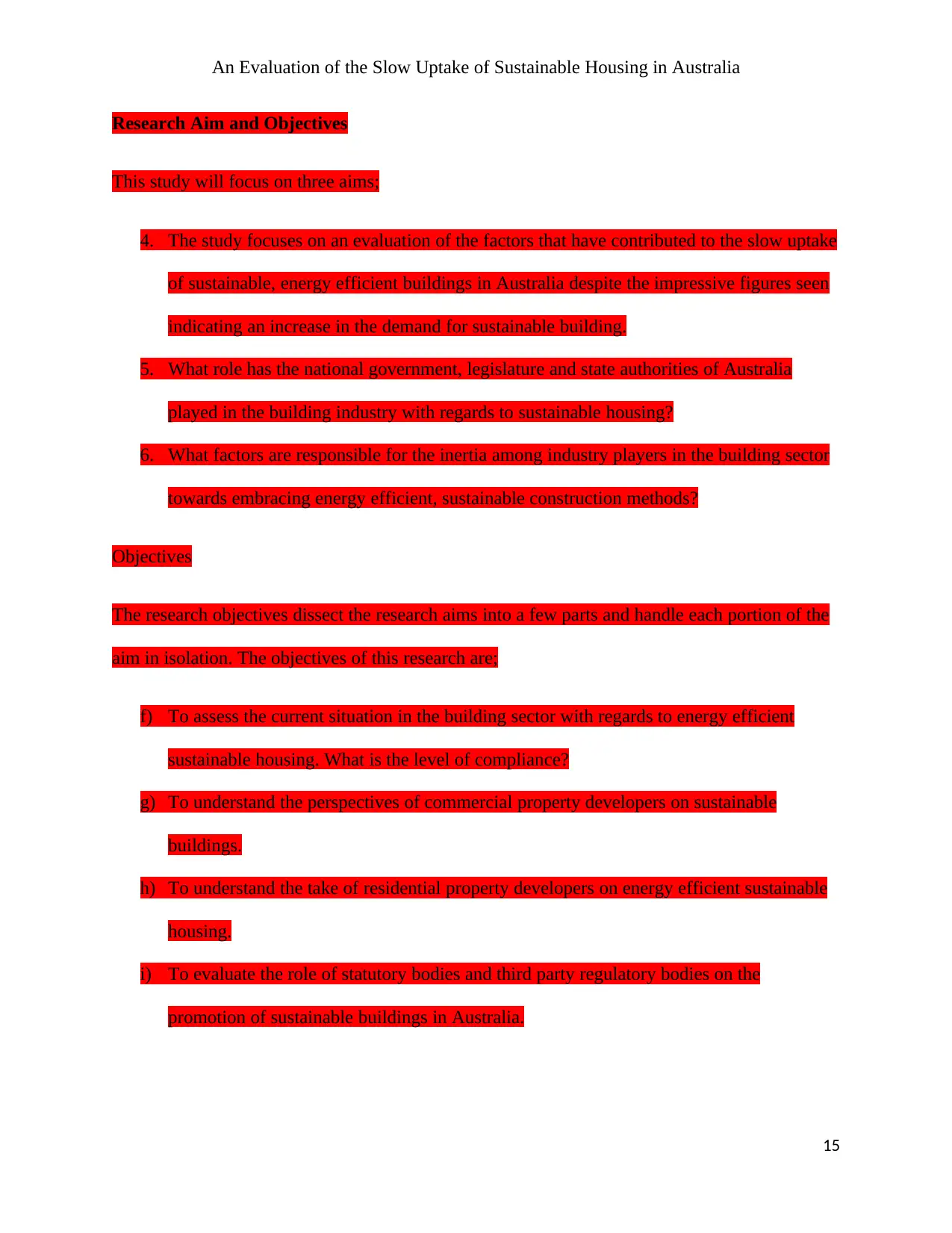
An Evaluation of the Slow Uptake of Sustainable Housing in Australia
Research Aim and Objectives
This study will focus on three aims;
4. The study focuses on an evaluation of the factors that have contributed to the slow uptake
of sustainable, energy efficient buildings in Australia despite the impressive figures seen
indicating an increase in the demand for sustainable building.
5. What role has the national government, legislature and state authorities of Australia
played in the building industry with regards to sustainable housing?
6. What factors are responsible for the inertia among industry players in the building sector
towards embracing energy efficient, sustainable construction methods?
Objectives
The research objectives dissect the research aims into a few parts and handle each portion of the
aim in isolation. The objectives of this research are;
f) To assess the current situation in the building sector with regards to energy efficient
sustainable housing. What is the level of compliance?
g) To understand the perspectives of commercial property developers on sustainable
buildings.
h) To understand the take of residential property developers on energy efficient sustainable
housing.
i) To evaluate the role of statutory bodies and third party regulatory bodies on the
promotion of sustainable buildings in Australia.
15
Research Aim and Objectives
This study will focus on three aims;
4. The study focuses on an evaluation of the factors that have contributed to the slow uptake
of sustainable, energy efficient buildings in Australia despite the impressive figures seen
indicating an increase in the demand for sustainable building.
5. What role has the national government, legislature and state authorities of Australia
played in the building industry with regards to sustainable housing?
6. What factors are responsible for the inertia among industry players in the building sector
towards embracing energy efficient, sustainable construction methods?
Objectives
The research objectives dissect the research aims into a few parts and handle each portion of the
aim in isolation. The objectives of this research are;
f) To assess the current situation in the building sector with regards to energy efficient
sustainable housing. What is the level of compliance?
g) To understand the perspectives of commercial property developers on sustainable
buildings.
h) To understand the take of residential property developers on energy efficient sustainable
housing.
i) To evaluate the role of statutory bodies and third party regulatory bodies on the
promotion of sustainable buildings in Australia.
15

An Evaluation of the Slow Uptake of Sustainable Housing in Australia
j) To evaluate the role of the national and state governments in Australia in the promotion
of energy-efficient and sustainable housing. What measures could the government initiate
in order to enhance the uptake of green housing in Australia?
Literature Review
Greenhouse gases remain one of the largest contributors to global warming and climate change.
Buildings contribute a significant share to the global greenhouse gas emissions 40%. Buildings
also account for about 30% of the total energy consumption according to the United Nations
Environmental Program. These figures support the proposition that the development of energy
efficient and sustainable buildings will greatly reduce the amount of green-house gas emissions.
This study will add its voice to the list of authorities who have already spoken and written about
the need for strategies to reduce greenhouse gas emissions as a way of combating climate
change. As such this study will contribute information that is critical to understanding the issues
around climate change and global warming and in addition make recommendations to how
remedies to the current global warming situation.
Methodology
This research will employ the use of both qualitative and quantitative methods. Given that the
research is largely descriptive in nature the qualitative approach is the most suitable. However, in
the analysis of data obtained by way of focus groups and in depth interviews, limited use of
SPSS (Statistical Packages for Social Sciences) may be employed. Descriptive research may
make use of qualitative of methods since it does not handle numerical data.
Data Collection
16
j) To evaluate the role of the national and state governments in Australia in the promotion
of energy-efficient and sustainable housing. What measures could the government initiate
in order to enhance the uptake of green housing in Australia?
Literature Review
Greenhouse gases remain one of the largest contributors to global warming and climate change.
Buildings contribute a significant share to the global greenhouse gas emissions 40%. Buildings
also account for about 30% of the total energy consumption according to the United Nations
Environmental Program. These figures support the proposition that the development of energy
efficient and sustainable buildings will greatly reduce the amount of green-house gas emissions.
This study will add its voice to the list of authorities who have already spoken and written about
the need for strategies to reduce greenhouse gas emissions as a way of combating climate
change. As such this study will contribute information that is critical to understanding the issues
around climate change and global warming and in addition make recommendations to how
remedies to the current global warming situation.
Methodology
This research will employ the use of both qualitative and quantitative methods. Given that the
research is largely descriptive in nature the qualitative approach is the most suitable. However, in
the analysis of data obtained by way of focus groups and in depth interviews, limited use of
SPSS (Statistical Packages for Social Sciences) may be employed. Descriptive research may
make use of qualitative of methods since it does not handle numerical data.
Data Collection
16
Secure Best Marks with AI Grader
Need help grading? Try our AI Grader for instant feedback on your assignments.
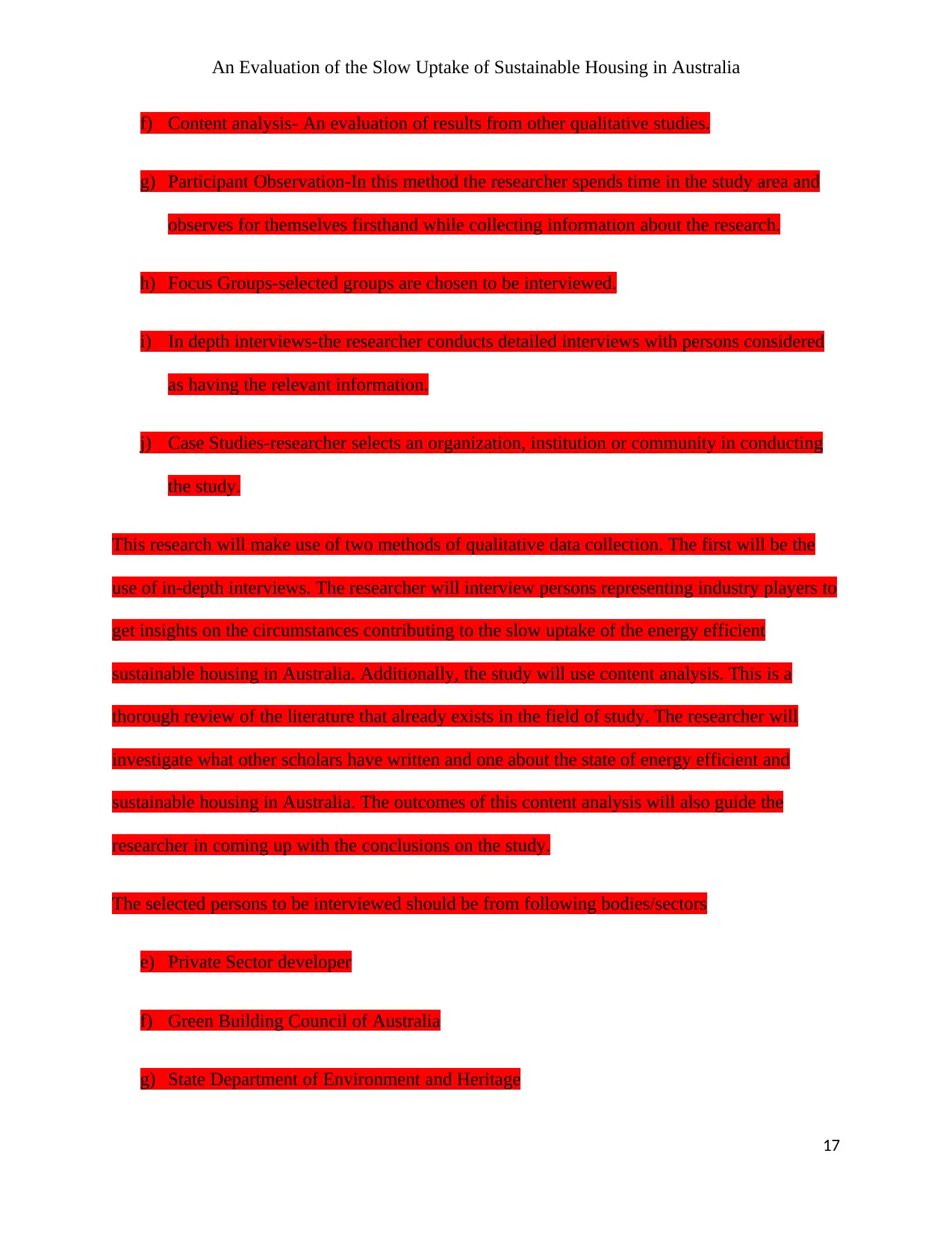
An Evaluation of the Slow Uptake of Sustainable Housing in Australia
f) Content analysis- An evaluation of results from other qualitative studies.
g) Participant Observation-In this method the researcher spends time in the study area and
observes for themselves firsthand while collecting information about the research.
h) Focus Groups-selected groups are chosen to be interviewed.
i) In depth interviews-the researcher conducts detailed interviews with persons considered
as having the relevant information.
j) Case Studies-researcher selects an organization, institution or community in conducting
the study.
This research will make use of two methods of qualitative data collection. The first will be the
use of in-depth interviews. The researcher will interview persons representing industry players to
get insights on the circumstances contributing to the slow uptake of the energy efficient
sustainable housing in Australia. Additionally, the study will use content analysis. This is a
thorough review of the literature that already exists in the field of study. The researcher will
investigate what other scholars have written and one about the state of energy efficient and
sustainable housing in Australia. The outcomes of this content analysis will also guide the
researcher in coming up with the conclusions on the study.
The selected persons to be interviewed should be from following bodies/sectors
e) Private Sector developer
f) Green Building Council of Australia
g) State Department of Environment and Heritage
17
f) Content analysis- An evaluation of results from other qualitative studies.
g) Participant Observation-In this method the researcher spends time in the study area and
observes for themselves firsthand while collecting information about the research.
h) Focus Groups-selected groups are chosen to be interviewed.
i) In depth interviews-the researcher conducts detailed interviews with persons considered
as having the relevant information.
j) Case Studies-researcher selects an organization, institution or community in conducting
the study.
This research will make use of two methods of qualitative data collection. The first will be the
use of in-depth interviews. The researcher will interview persons representing industry players to
get insights on the circumstances contributing to the slow uptake of the energy efficient
sustainable housing in Australia. Additionally, the study will use content analysis. This is a
thorough review of the literature that already exists in the field of study. The researcher will
investigate what other scholars have written and one about the state of energy efficient and
sustainable housing in Australia. The outcomes of this content analysis will also guide the
researcher in coming up with the conclusions on the study.
The selected persons to be interviewed should be from following bodies/sectors
e) Private Sector developer
f) Green Building Council of Australia
g) State Department of Environment and Heritage
17

An Evaluation of the Slow Uptake of Sustainable Housing in Australia
h) Australian Building Code Board
SPSS (Statistical Packages for Social Sciences) software for data analysis will be used for this
study to analyze and interpret the quantitative data obtained from the above 2 methods of data
collection i.e. interviews and focus groups. SPSS will analyze the descriptive statistics such as
frequencies as well as predictions in the identification of focus groups.
Discussion
The researcher observes with concern that there is not sufficient academic research that has been
done on the role that energy efficient and sustainable building methods could have in reducing
the amount of greenhouse gas emissions. The research therefore responds to the need for more
scholarly work on the necessity of adopting green building technologies and this paper is
responding to that need. In the same vein the research seeks to fill the gap in scholarly work
targeting green building technologies (GBT). Green building technologies are defined as the
practice of building structures by employing methods that are environmentally friendly and
efficient on resources throughout the life span of the building. It follows that construction of
buildings according to the green building technology would significantly cut on the consumption
of energy, minimize negative impacts on the environment and optimize resource utilization. This
is what is lacking in Australia’s building sector and the paper hopes to bring this up as a pertinent
issue.
Conclusion
Based on the literature review conducted and the study methods to be used, the study anticipates
a variety of issues to come up in the course of the research. They include but are not limited to
costs, insufficient public knowledge, fragmented construction process, age of the housing stock
18
h) Australian Building Code Board
SPSS (Statistical Packages for Social Sciences) software for data analysis will be used for this
study to analyze and interpret the quantitative data obtained from the above 2 methods of data
collection i.e. interviews and focus groups. SPSS will analyze the descriptive statistics such as
frequencies as well as predictions in the identification of focus groups.
Discussion
The researcher observes with concern that there is not sufficient academic research that has been
done on the role that energy efficient and sustainable building methods could have in reducing
the amount of greenhouse gas emissions. The research therefore responds to the need for more
scholarly work on the necessity of adopting green building technologies and this paper is
responding to that need. In the same vein the research seeks to fill the gap in scholarly work
targeting green building technologies (GBT). Green building technologies are defined as the
practice of building structures by employing methods that are environmentally friendly and
efficient on resources throughout the life span of the building. It follows that construction of
buildings according to the green building technology would significantly cut on the consumption
of energy, minimize negative impacts on the environment and optimize resource utilization. This
is what is lacking in Australia’s building sector and the paper hopes to bring this up as a pertinent
issue.
Conclusion
Based on the literature review conducted and the study methods to be used, the study anticipates
a variety of issues to come up in the course of the research. They include but are not limited to
costs, insufficient public knowledge, fragmented construction process, age of the housing stock
18

An Evaluation of the Slow Uptake of Sustainable Housing in Australia
and administrative barriers. Assuming that high cost of construction is the reason causing
developers to shy from construction of sustainable houses, the study suggests that more research
will be required to device more cost-efficient methods of sustainable building. Administrative
barriers such as complex bottlenecks and certification processes can be removed through inactive
engagement between all the industry players and the state agencies.
19
and administrative barriers. Assuming that high cost of construction is the reason causing
developers to shy from construction of sustainable houses, the study suggests that more research
will be required to device more cost-efficient methods of sustainable building. Administrative
barriers such as complex bottlenecks and certification processes can be removed through inactive
engagement between all the industry players and the state agencies.
19
Paraphrase This Document
Need a fresh take? Get an instant paraphrase of this document with our AI Paraphraser
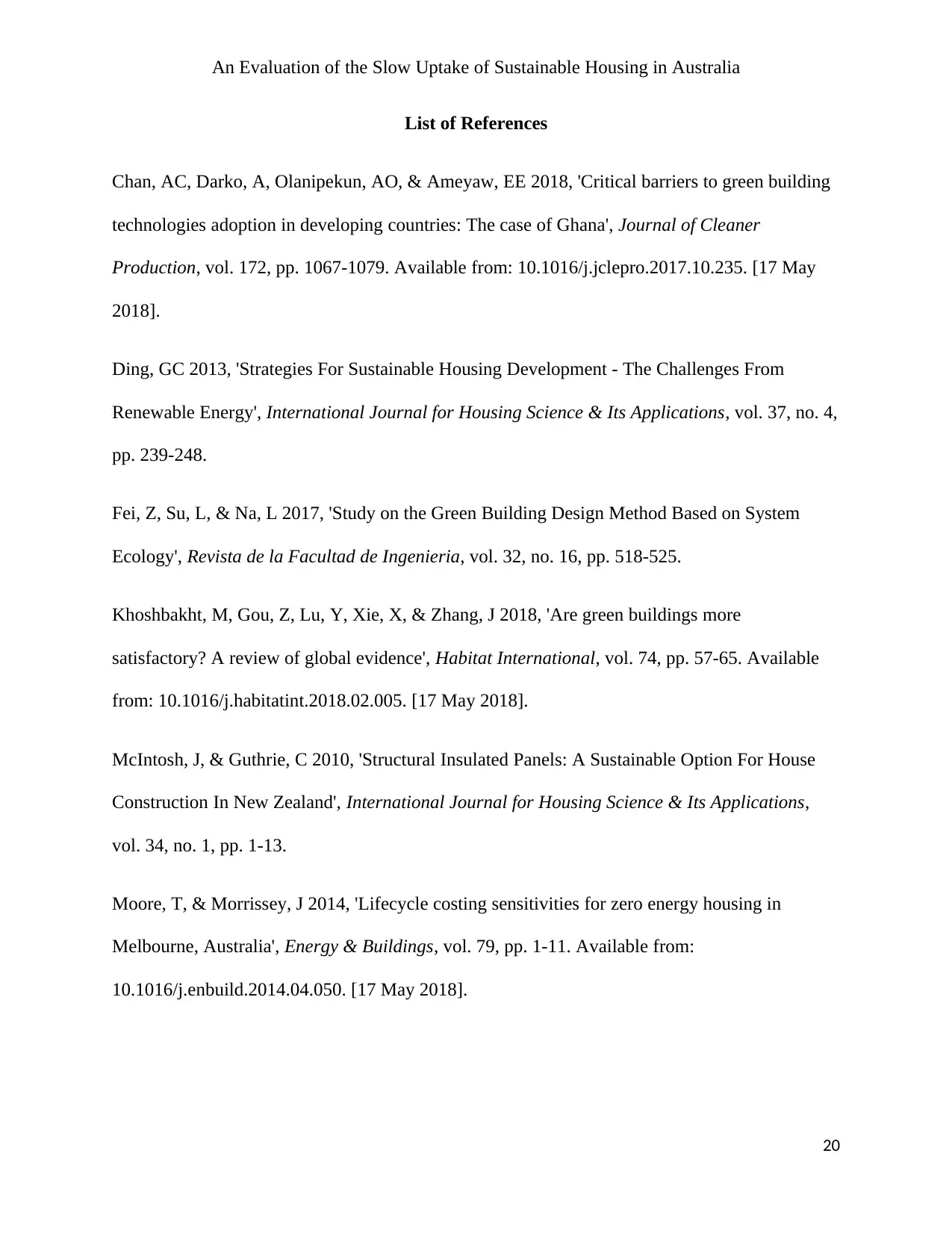
An Evaluation of the Slow Uptake of Sustainable Housing in Australia
List of References
Chan, AC, Darko, A, Olanipekun, AO, & Ameyaw, EE 2018, 'Critical barriers to green building
technologies adoption in developing countries: The case of Ghana', Journal of Cleaner
Production, vol. 172, pp. 1067-1079. Available from: 10.1016/j.jclepro.2017.10.235. [17 May
2018].
Ding, GC 2013, 'Strategies For Sustainable Housing Development - The Challenges From
Renewable Energy', International Journal for Housing Science & Its Applications, vol. 37, no. 4,
pp. 239-248.
Fei, Z, Su, L, & Na, L 2017, 'Study on the Green Building Design Method Based on System
Ecology', Revista de la Facultad de Ingenieria, vol. 32, no. 16, pp. 518-525.
Khoshbakht, M, Gou, Z, Lu, Y, Xie, X, & Zhang, J 2018, 'Are green buildings more
satisfactory? A review of global evidence', Habitat International, vol. 74, pp. 57-65. Available
from: 10.1016/j.habitatint.2018.02.005. [17 May 2018].
McIntosh, J, & Guthrie, C 2010, 'Structural Insulated Panels: A Sustainable Option For House
Construction In New Zealand', International Journal for Housing Science & Its Applications,
vol. 34, no. 1, pp. 1-13.
Moore, T, & Morrissey, J 2014, 'Lifecycle costing sensitivities for zero energy housing in
Melbourne, Australia', Energy & Buildings, vol. 79, pp. 1-11. Available from:
10.1016/j.enbuild.2014.04.050. [17 May 2018].
20
List of References
Chan, AC, Darko, A, Olanipekun, AO, & Ameyaw, EE 2018, 'Critical barriers to green building
technologies adoption in developing countries: The case of Ghana', Journal of Cleaner
Production, vol. 172, pp. 1067-1079. Available from: 10.1016/j.jclepro.2017.10.235. [17 May
2018].
Ding, GC 2013, 'Strategies For Sustainable Housing Development - The Challenges From
Renewable Energy', International Journal for Housing Science & Its Applications, vol. 37, no. 4,
pp. 239-248.
Fei, Z, Su, L, & Na, L 2017, 'Study on the Green Building Design Method Based on System
Ecology', Revista de la Facultad de Ingenieria, vol. 32, no. 16, pp. 518-525.
Khoshbakht, M, Gou, Z, Lu, Y, Xie, X, & Zhang, J 2018, 'Are green buildings more
satisfactory? A review of global evidence', Habitat International, vol. 74, pp. 57-65. Available
from: 10.1016/j.habitatint.2018.02.005. [17 May 2018].
McIntosh, J, & Guthrie, C 2010, 'Structural Insulated Panels: A Sustainable Option For House
Construction In New Zealand', International Journal for Housing Science & Its Applications,
vol. 34, no. 1, pp. 1-13.
Moore, T, & Morrissey, J 2014, 'Lifecycle costing sensitivities for zero energy housing in
Melbourne, Australia', Energy & Buildings, vol. 79, pp. 1-11. Available from:
10.1016/j.enbuild.2014.04.050. [17 May 2018].
20
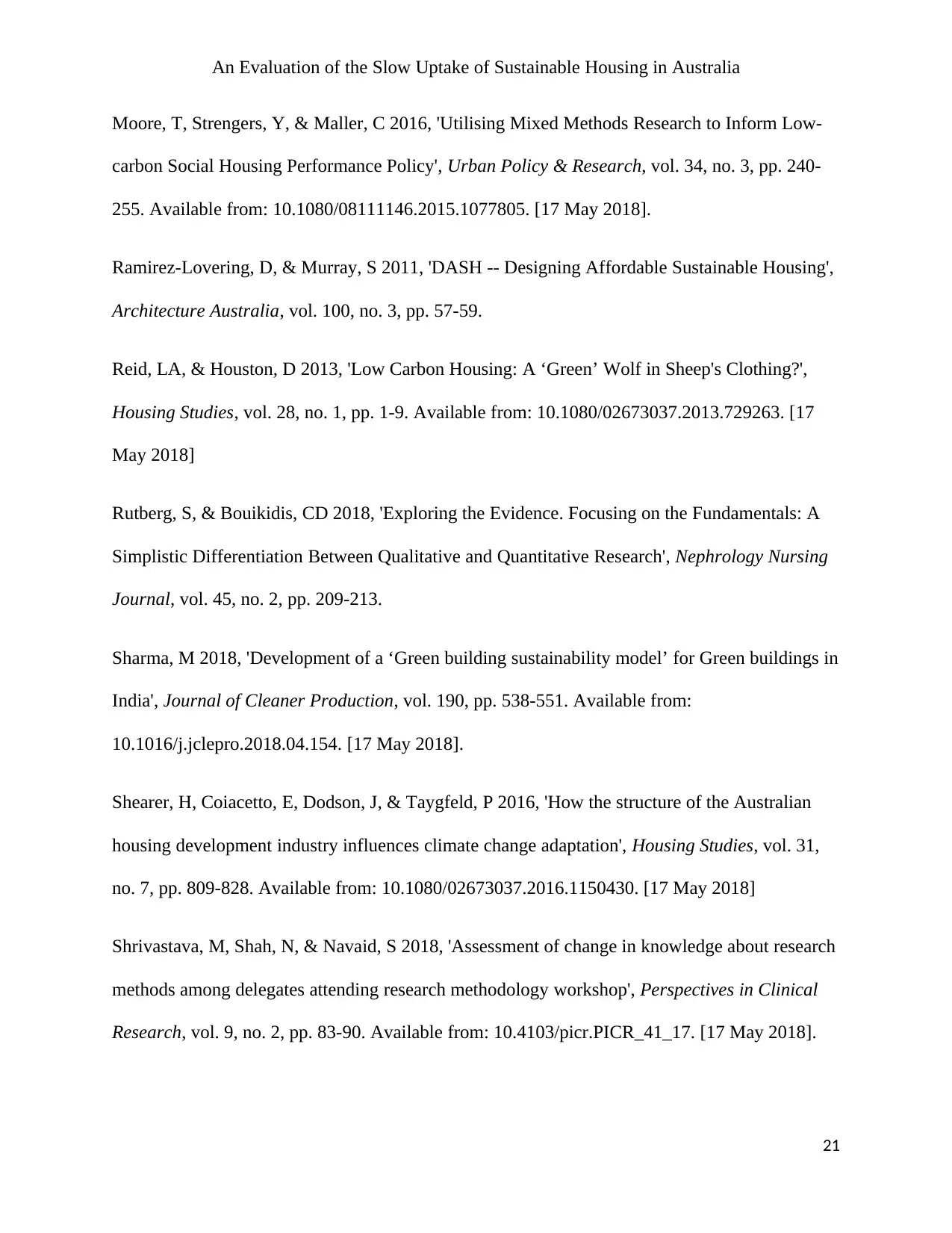
An Evaluation of the Slow Uptake of Sustainable Housing in Australia
Moore, T, Strengers, Y, & Maller, C 2016, 'Utilising Mixed Methods Research to Inform Low-
carbon Social Housing Performance Policy', Urban Policy & Research, vol. 34, no. 3, pp. 240-
255. Available from: 10.1080/08111146.2015.1077805. [17 May 2018].
Ramirez-Lovering, D, & Murray, S 2011, 'DASH -- Designing Affordable Sustainable Housing',
Architecture Australia, vol. 100, no. 3, pp. 57-59.
Reid, LA, & Houston, D 2013, 'Low Carbon Housing: A ‘Green’ Wolf in Sheep's Clothing?',
Housing Studies, vol. 28, no. 1, pp. 1-9. Available from: 10.1080/02673037.2013.729263. [17
May 2018]
Rutberg, S, & Bouikidis, CD 2018, 'Exploring the Evidence. Focusing on the Fundamentals: A
Simplistic Differentiation Between Qualitative and Quantitative Research', Nephrology Nursing
Journal, vol. 45, no. 2, pp. 209-213.
Sharma, M 2018, 'Development of a ‘Green building sustainability model’ for Green buildings in
India', Journal of Cleaner Production, vol. 190, pp. 538-551. Available from:
10.1016/j.jclepro.2018.04.154. [17 May 2018].
Shearer, H, Coiacetto, E, Dodson, J, & Taygfeld, P 2016, 'How the structure of the Australian
housing development industry influences climate change adaptation', Housing Studies, vol. 31,
no. 7, pp. 809-828. Available from: 10.1080/02673037.2016.1150430. [17 May 2018]
Shrivastava, M, Shah, N, & Navaid, S 2018, 'Assessment of change in knowledge about research
methods among delegates attending research methodology workshop', Perspectives in Clinical
Research, vol. 9, no. 2, pp. 83-90. Available from: 10.4103/picr.PICR_41_17. [17 May 2018].
21
Moore, T, Strengers, Y, & Maller, C 2016, 'Utilising Mixed Methods Research to Inform Low-
carbon Social Housing Performance Policy', Urban Policy & Research, vol. 34, no. 3, pp. 240-
255. Available from: 10.1080/08111146.2015.1077805. [17 May 2018].
Ramirez-Lovering, D, & Murray, S 2011, 'DASH -- Designing Affordable Sustainable Housing',
Architecture Australia, vol. 100, no. 3, pp. 57-59.
Reid, LA, & Houston, D 2013, 'Low Carbon Housing: A ‘Green’ Wolf in Sheep's Clothing?',
Housing Studies, vol. 28, no. 1, pp. 1-9. Available from: 10.1080/02673037.2013.729263. [17
May 2018]
Rutberg, S, & Bouikidis, CD 2018, 'Exploring the Evidence. Focusing on the Fundamentals: A
Simplistic Differentiation Between Qualitative and Quantitative Research', Nephrology Nursing
Journal, vol. 45, no. 2, pp. 209-213.
Sharma, M 2018, 'Development of a ‘Green building sustainability model’ for Green buildings in
India', Journal of Cleaner Production, vol. 190, pp. 538-551. Available from:
10.1016/j.jclepro.2018.04.154. [17 May 2018].
Shearer, H, Coiacetto, E, Dodson, J, & Taygfeld, P 2016, 'How the structure of the Australian
housing development industry influences climate change adaptation', Housing Studies, vol. 31,
no. 7, pp. 809-828. Available from: 10.1080/02673037.2016.1150430. [17 May 2018]
Shrivastava, M, Shah, N, & Navaid, S 2018, 'Assessment of change in knowledge about research
methods among delegates attending research methodology workshop', Perspectives in Clinical
Research, vol. 9, no. 2, pp. 83-90. Available from: 10.4103/picr.PICR_41_17. [17 May 2018].
21
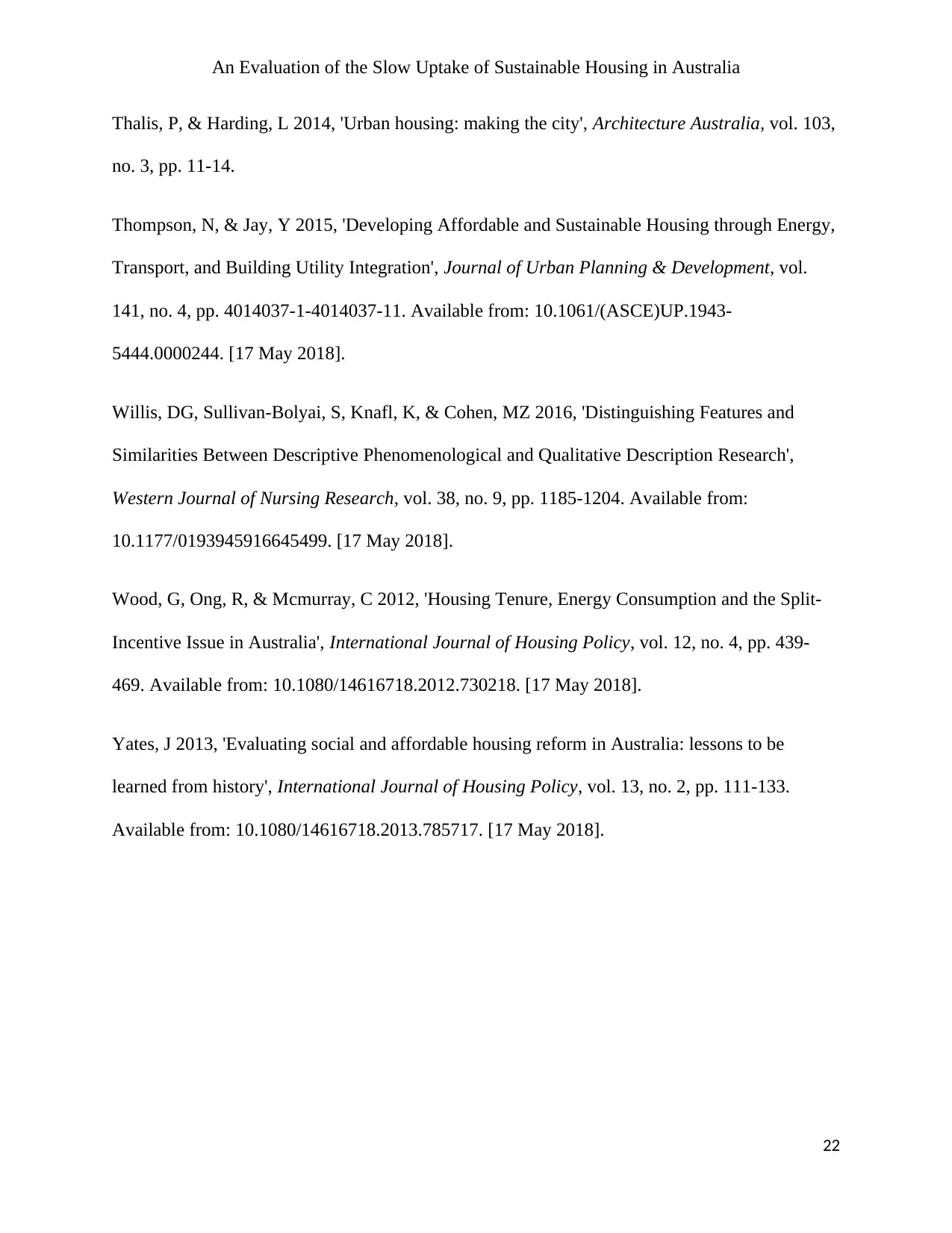
An Evaluation of the Slow Uptake of Sustainable Housing in Australia
Thalis, P, & Harding, L 2014, 'Urban housing: making the city', Architecture Australia, vol. 103,
no. 3, pp. 11-14.
Thompson, N, & Jay, Y 2015, 'Developing Affordable and Sustainable Housing through Energy,
Transport, and Building Utility Integration', Journal of Urban Planning & Development, vol.
141, no. 4, pp. 4014037-1-4014037-11. Available from: 10.1061/(ASCE)UP.1943-
5444.0000244. [17 May 2018].
Willis, DG, Sullivan-Bolyai, S, Knafl, K, & Cohen, MZ 2016, 'Distinguishing Features and
Similarities Between Descriptive Phenomenological and Qualitative Description Research',
Western Journal of Nursing Research, vol. 38, no. 9, pp. 1185-1204. Available from:
10.1177/0193945916645499. [17 May 2018].
Wood, G, Ong, R, & Mcmurray, C 2012, 'Housing Tenure, Energy Consumption and the Split-
Incentive Issue in Australia', International Journal of Housing Policy, vol. 12, no. 4, pp. 439-
469. Available from: 10.1080/14616718.2012.730218. [17 May 2018].
Yates, J 2013, 'Evaluating social and affordable housing reform in Australia: lessons to be
learned from history', International Journal of Housing Policy, vol. 13, no. 2, pp. 111-133.
Available from: 10.1080/14616718.2013.785717. [17 May 2018].
22
Thalis, P, & Harding, L 2014, 'Urban housing: making the city', Architecture Australia, vol. 103,
no. 3, pp. 11-14.
Thompson, N, & Jay, Y 2015, 'Developing Affordable and Sustainable Housing through Energy,
Transport, and Building Utility Integration', Journal of Urban Planning & Development, vol.
141, no. 4, pp. 4014037-1-4014037-11. Available from: 10.1061/(ASCE)UP.1943-
5444.0000244. [17 May 2018].
Willis, DG, Sullivan-Bolyai, S, Knafl, K, & Cohen, MZ 2016, 'Distinguishing Features and
Similarities Between Descriptive Phenomenological and Qualitative Description Research',
Western Journal of Nursing Research, vol. 38, no. 9, pp. 1185-1204. Available from:
10.1177/0193945916645499. [17 May 2018].
Wood, G, Ong, R, & Mcmurray, C 2012, 'Housing Tenure, Energy Consumption and the Split-
Incentive Issue in Australia', International Journal of Housing Policy, vol. 12, no. 4, pp. 439-
469. Available from: 10.1080/14616718.2012.730218. [17 May 2018].
Yates, J 2013, 'Evaluating social and affordable housing reform in Australia: lessons to be
learned from history', International Journal of Housing Policy, vol. 13, no. 2, pp. 111-133.
Available from: 10.1080/14616718.2013.785717. [17 May 2018].
22
Secure Best Marks with AI Grader
Need help grading? Try our AI Grader for instant feedback on your assignments.

An Evaluation of the Slow Uptake of Sustainable Housing in Australia
23
23

An Evaluation of the Slow Uptake of Sustainable Housing in Australia
24
24
1 out of 24
Related Documents
Your All-in-One AI-Powered Toolkit for Academic Success.
+13062052269
info@desklib.com
Available 24*7 on WhatsApp / Email
![[object Object]](/_next/static/media/star-bottom.7253800d.svg)
Unlock your academic potential
© 2024 | Zucol Services PVT LTD | All rights reserved.



